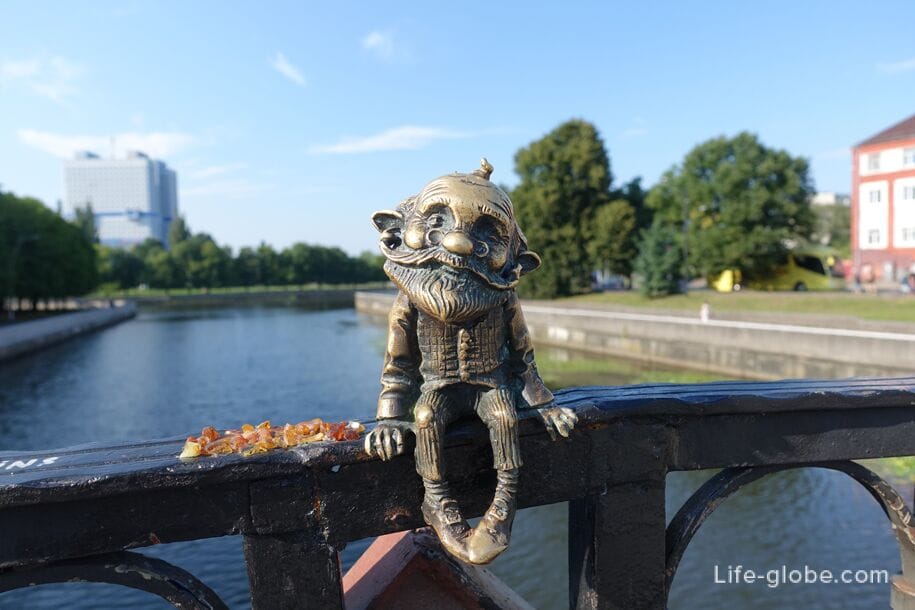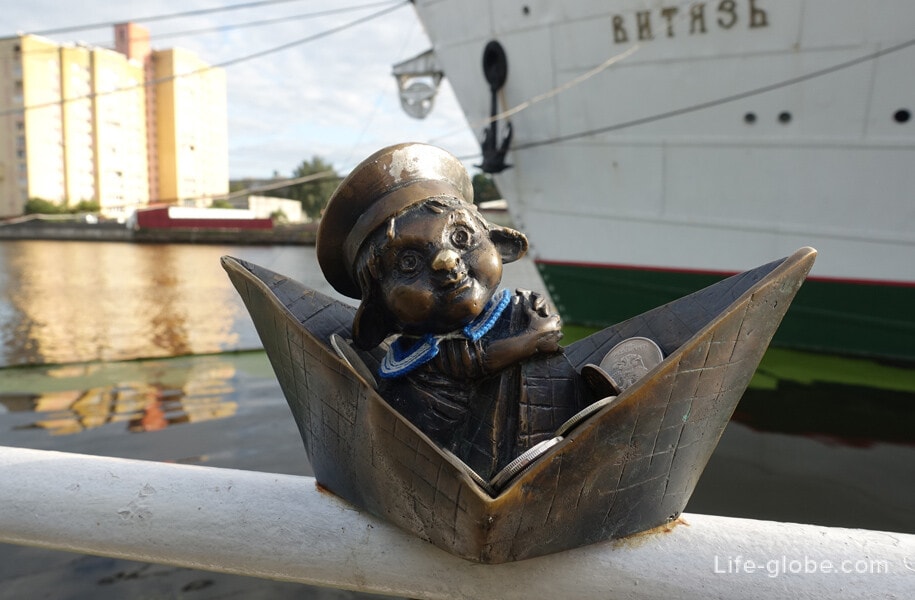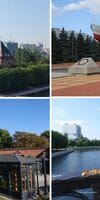Kaliningrad is a city with a rich history, founded by the Teutonic Order as a castle in 1255 and was a fortress city throughout almost the entire history of the existence of Konigsberg (now Kaliningrad).
Due to its two-faced history, Kaliningrad is not only a beautiful city, but also a place where there are a considerable number of attractions that can tell their guests about the history, heterogeneous culture of the region and the lifestyle of the inhabitants of Konigsberg-Kaliningrad.
This article contains the most complete list of attractions, museums, parks, lakes, significant objects and interesting places in Kaliningrad. If you want to learn only about the most important sights and museums of the city, or you have only 1-2-3 days to Kaliningrad, then you can see the list of top attractions and museums here →
Sights of Kaliningrad
Fish Village
Fish Village is an ethnographic and trade and craft complex located in the heart of Kaliningrad, on the banks of the Pregolya River (Veterans Embankment).
The complex "Fish Village" is stylized as the pre-war East Prussian city of Koenigsberg. The complex itself is small, stretches from the Honey Bridge connecting the fish village with the island of Kanta to the High Bridge and is an embankment.
Cafes, restaurants and shops are located on the embankment, there is an observation tower "Mayak", the 4-star Kaiserhof Hotel, the 3-star Skipper Hotel and the hotel "At the Honey Bridge", and from the piers of the Fishing Village you can go for a boat trip along the Pregolya River. More about the fishing village...
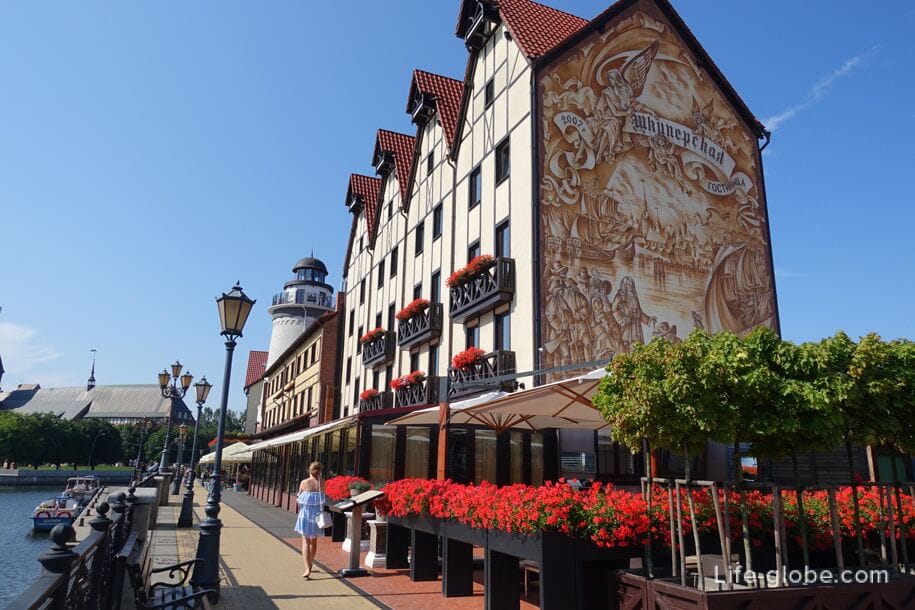
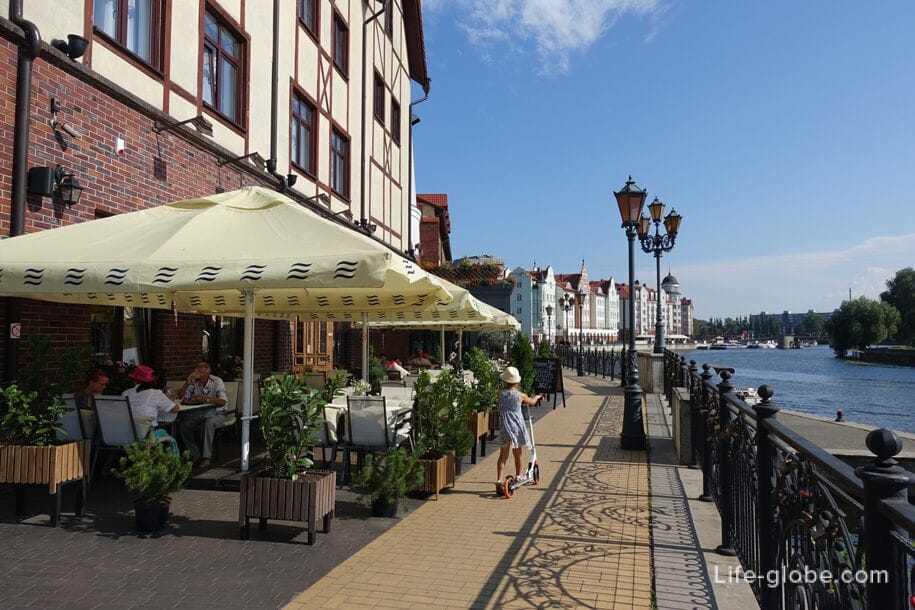
New Synagogue
The New Liberal Synagogue or Konigsberg Synagogue (Neue Liberale Synagogue Königsberg), was originally built in Konigsberg in the late 1890s and destroyed - burned, and then finally destroyed, during World War II.
The building, 46 meters high, was made in the style of a combination of Gothic with Moorish forms and neo-Renaissance.
The synagogue was rebuilt in its former forms and in the same place where the Konigsberg Synagogue used to be, in the period 2011-2018 (2020 - interior decoration).
The facade, dome and main rooms of the New Synagogue are as close as possible to their historical appearance.
Paid excursions are conducted around the synagogue.
The synagogue is located near the "Fish Village" at the address: Oktyabrskaya Street, 1a. Learn more about the New Synagogue...
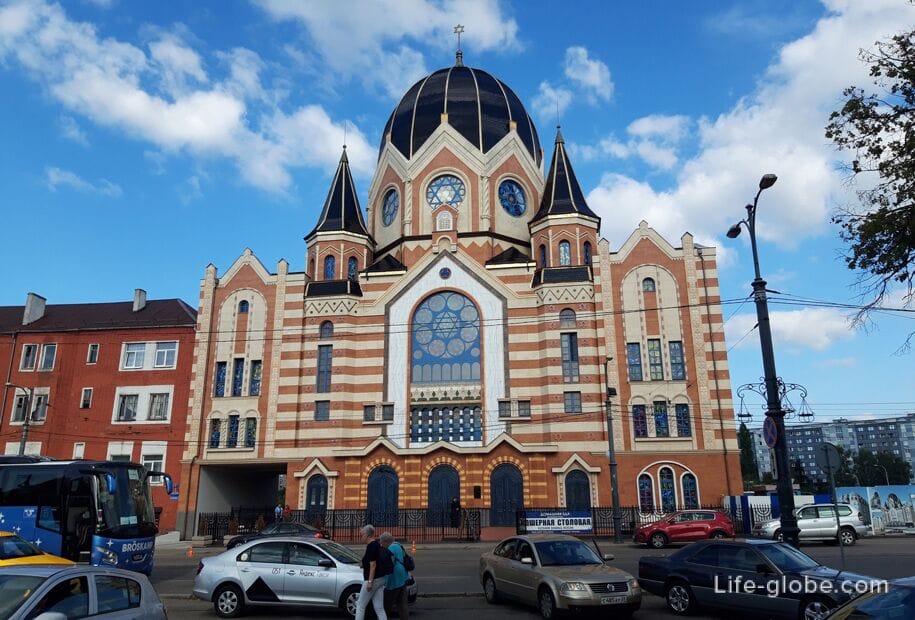
Next to the synagogue is the historic building of the Jewish orphanage with an evening school, which was originally built in Konigsberg in 1904-1905 by architect Friedrich Heitmann.
During the Second World War, the building received significant damage. It was later restored and is now preserved in a substantially modified form.
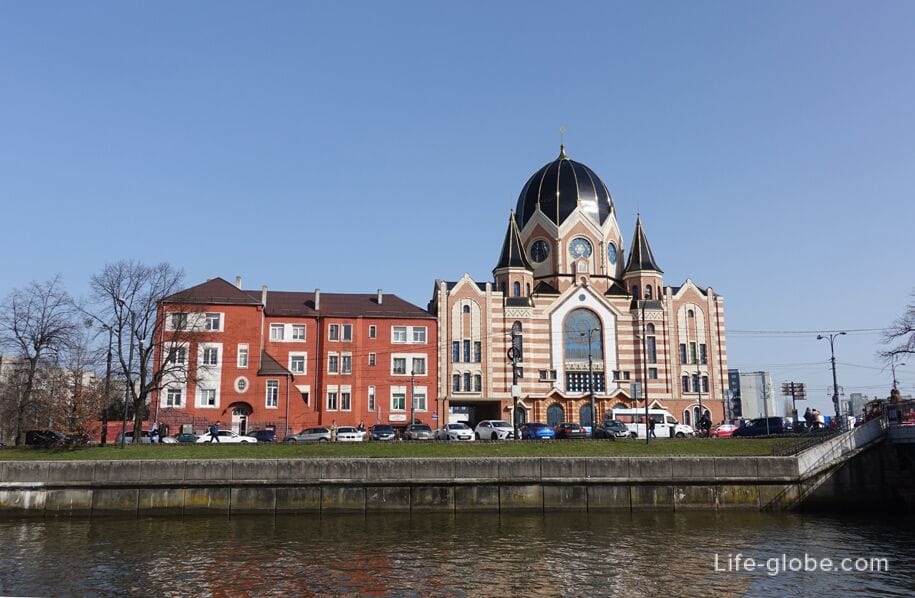
Kant Island with a cathedral
Kant Island, full name Immanuel Kant Island is a historical non-residential island part of the city of Kaliningrad, located surrounded by the Pregolya River.
Previously, the island of Kant was called Kneiphof, which comes from the Prussian "Knypabe", which means "Surrounded by water, river".
The main attractions of Kant Island: the Cathedral, which was originally the main Catholic church of Konigsberg; Kant's grave and sculpture park, as well as Honey bridge connecting the island with the Fishing Village.
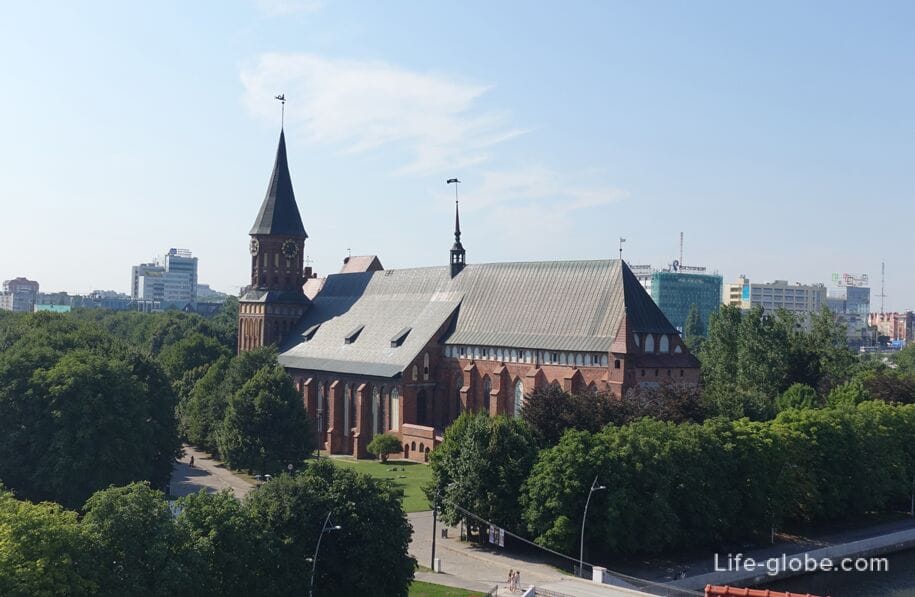
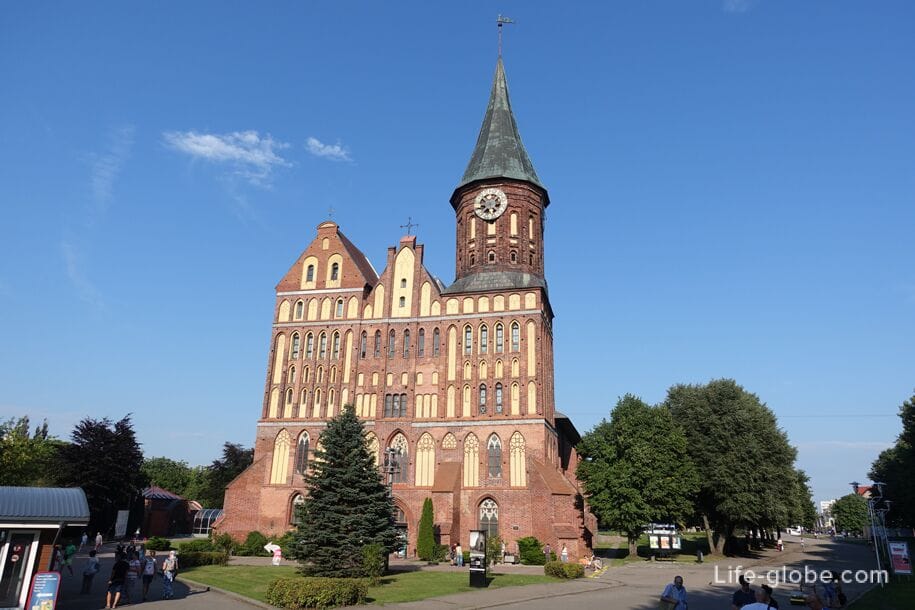
The building of the Konigsberg Stock Exchange
The building of the former Konigsberg Stock Exchange (Konigsberg Stock Exchange / Königsberger Börse) is made in the Neo-Renaissance style with elements of classicism.
The exchange building was built in 1870-1875. Part of the exchange building was on land, while the other was on the water. There is a version that transactions concluded in an exchange located on the water were not taxed.
In August 1944, the exchange was damaged - all the wooden structures of the building burned out.
The reconstruction of the exchange building was started in 1967. The exterior of the building was preserved, while the interiors underwent alterations.
Currently, the Museum of Fine Arts is located in the walls of the exchange.
The address of the former exchange: Leninsky Prospekt, 83. Learn more about the Stock exchange and the Museum of Fine Arts...
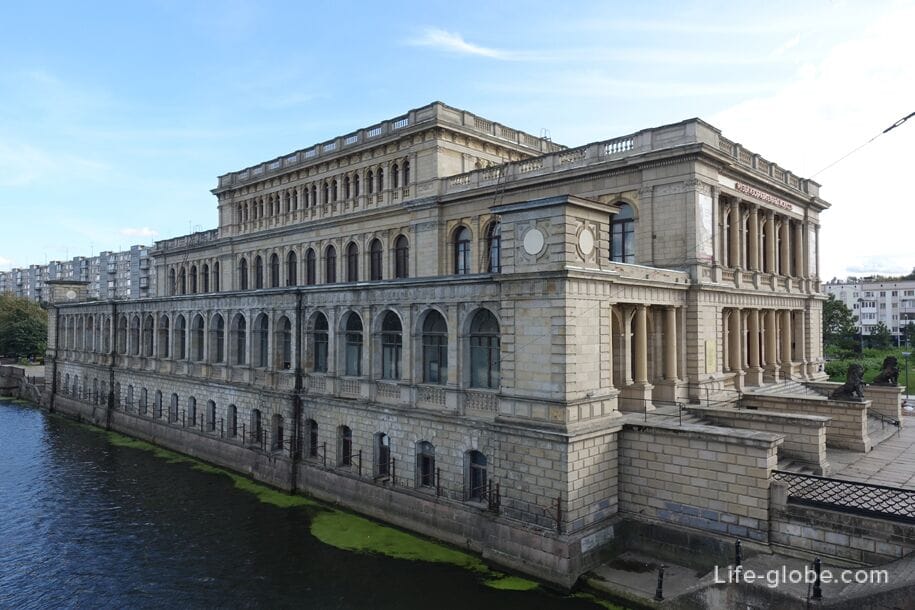
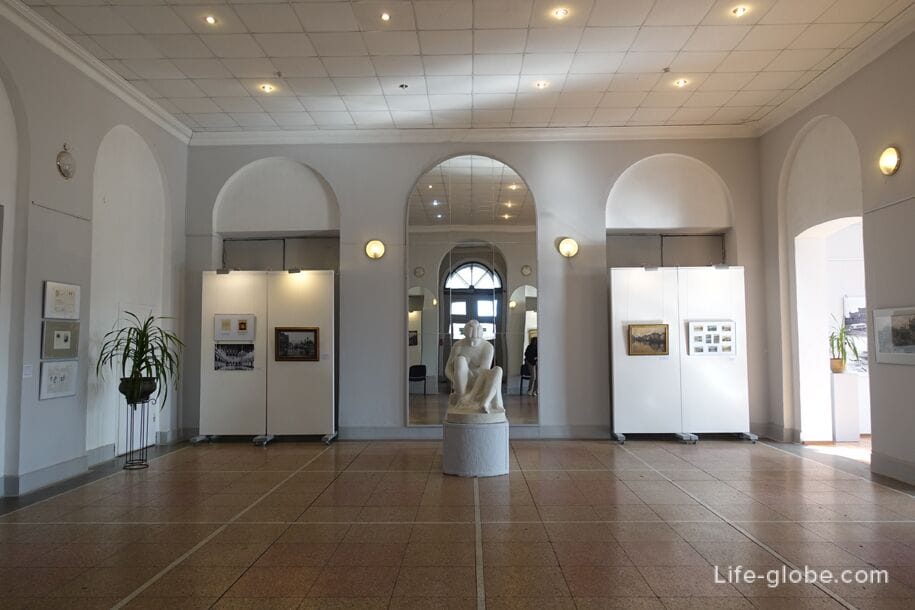
Behind the building of the former exchange there is a small "square on Leninsky Prospekt" also known as the "square at the Exchange", which attracts by the fact that in its center there is a light-musical (singing) fountain (in the warmer months).
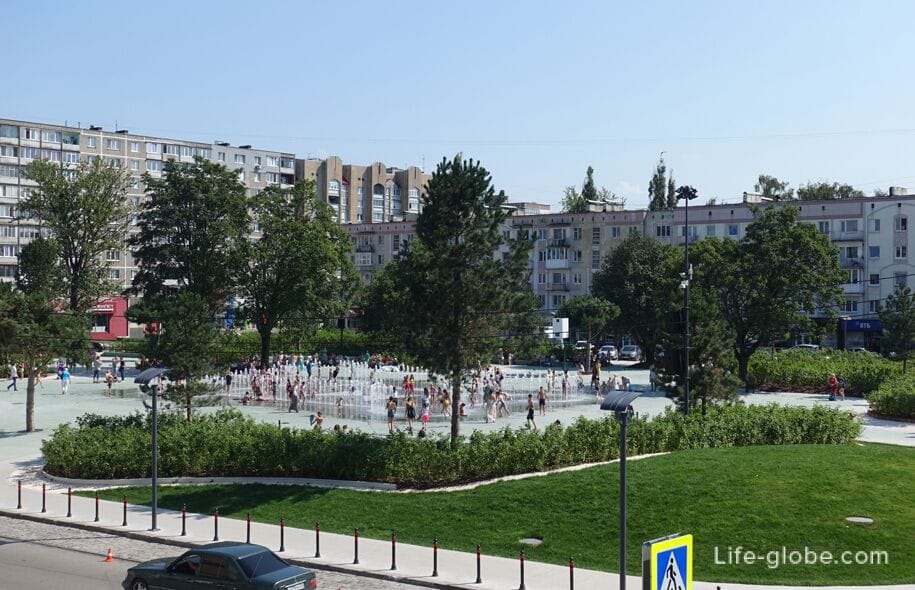
High Bridge Caretaker's House (Munchausen House)
The High Bridge Caretaker's house was built in 1899 on the riverbank near the High Bridge.
The building is made of red brick in the Neo-Gothic style. In the house there were lifting mechanisms for the divorce of a High bridge.
The High Bridge Caretaker's house is also known as "Baron Munchausen's house". Several legends about Munchausen are connected with the history of the house, who was a real historical figure and a prototype of a literary hero who traveled from Bodenwerder (a city in Germany) to St. Petersburg, where he went to serve in the Russian army, and, among other things, visited Konigsberg.
Today, the museum of postcards is located on the walls of the former house of the bridge caretaker. You can also drink coffee and buy marzipan.
The address of the caretaker's house: 4 Bagration Street. More about the caretaker's house, the museum and the legends of Munchausen...
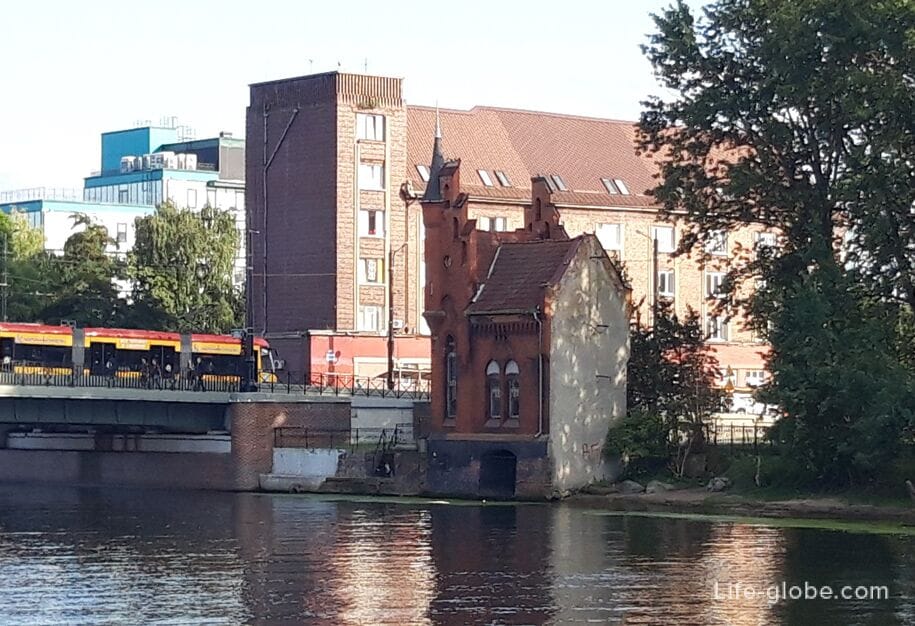
Kaliningrad Stadium
Kaliningrad Stadium is the largest stadium in the Kaliningrad region, built to host matches of the 2018 FIFA World Cup.
The stadium is located on Oktyabrsky Island, at the address: Sunny Boulevard, 25.
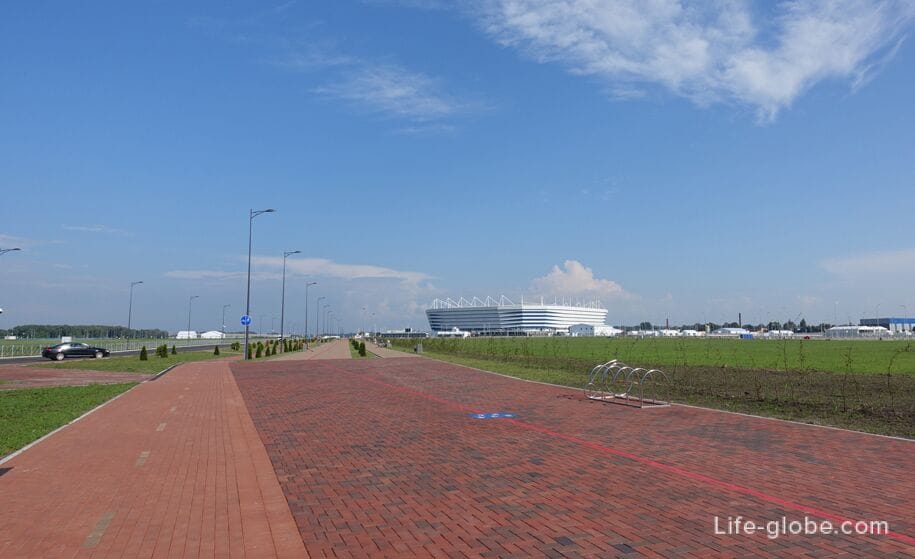
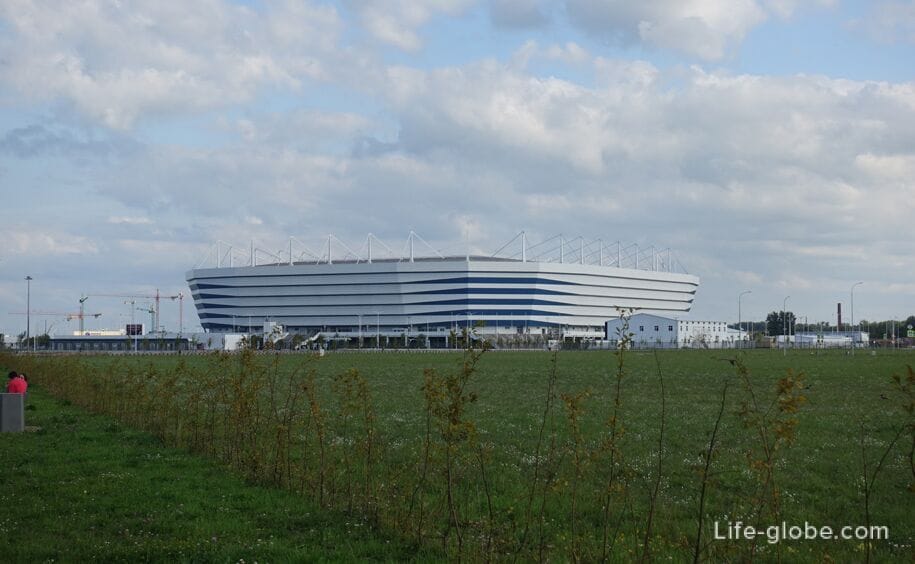
Holy Cross Cathedral
Holy Cross Cathedral, formerly the Lutheran-Evangelical Church of the Cross or Kreuzkirche, which was consecrated in 1933, and is now an Orthodox church.
Currently, the Holy Cross Cathedral attracts attention, first of all, with its appearance with the image of a huge cross on the facade, between two equally high towers, which are completed with small domes. The towers are connected by a covered gallery.
The interior of the shrine was restored in accordance with Orthodox canons. The main attraction of the current cathedral is a unique amber iconostasis.
The address of the cathedral: Oktyabrsky Island, General Pavlov Street, 2. Read more about the Holy Cross Cathedral...
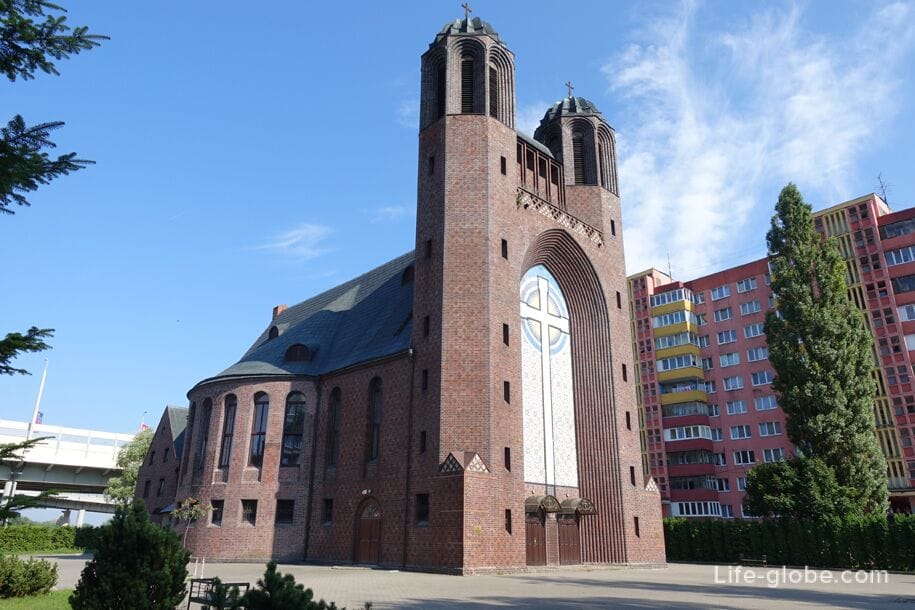
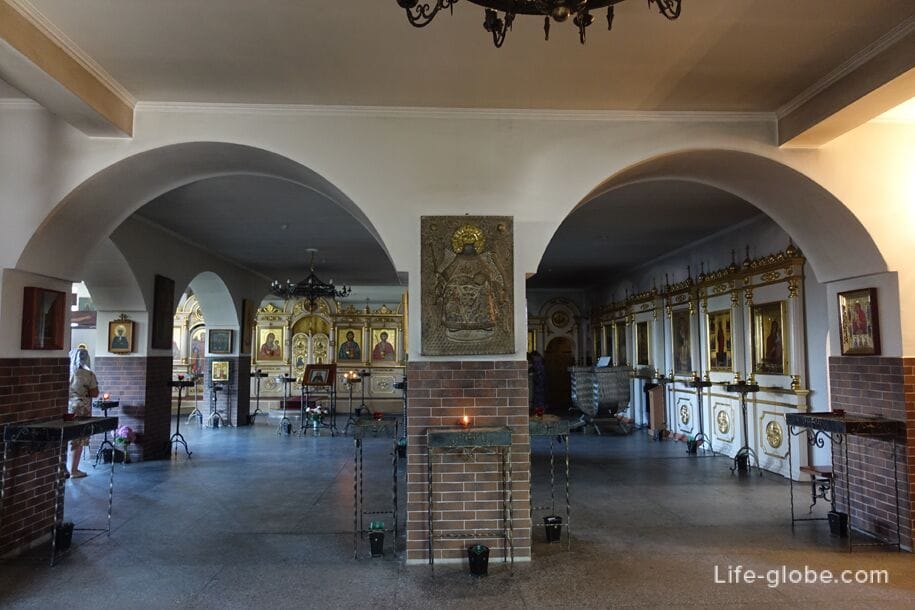
St. George's Hospital Building
St. George's Hospital was founded by the master of the Teutonic Order in 1329.
Construction of the current hospital building began in 1894 and was inaugurated in 1897.
Today, the Kaliningrad Marine Fisheries College is located within the walls of the former hospital.
The building is made of red clinker brick in the Neo-Gothic style. The main building has a sloping facade, decorated on both sides with high towers with sharp spires and a strict Gothic portal (entrance).
Building address: 3 Morehodnaya Street. More about the building of the former St. George's Hospital...
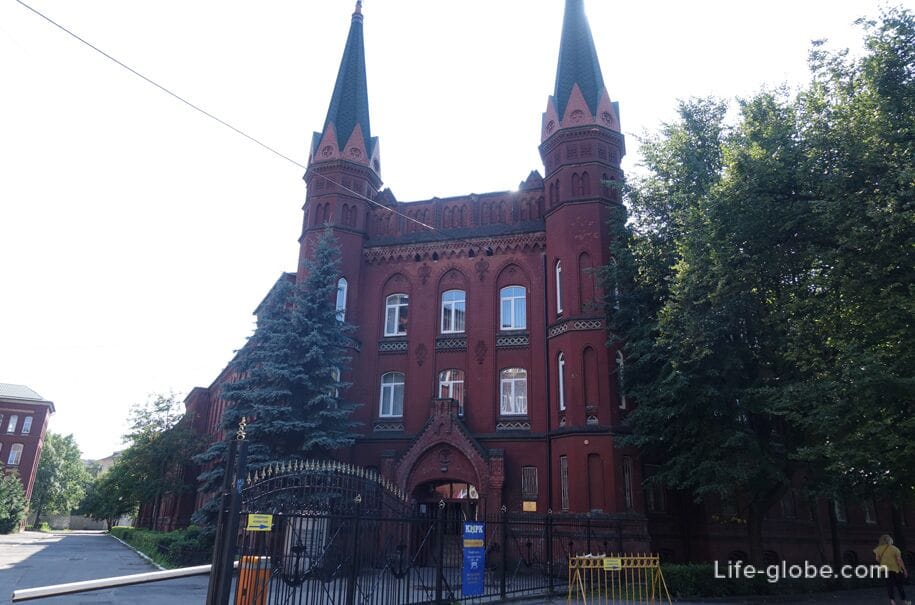
The ruins of Konigsberg Castle and the "House of Soviets"
Near the Fishing Village and the island of Kanta, on the Central Square, there are two inconspicuous, but well-known sights of the city:
- small remains of the once majestic Royal Castle (Konigsberg Castle / Das Königsberger Schloß), whose history dates back to the time of the Teutonic Order (1255) and from which the history of Konigsberg and, accordingly, Kaliningrad began. More about Konigsberg Castle...
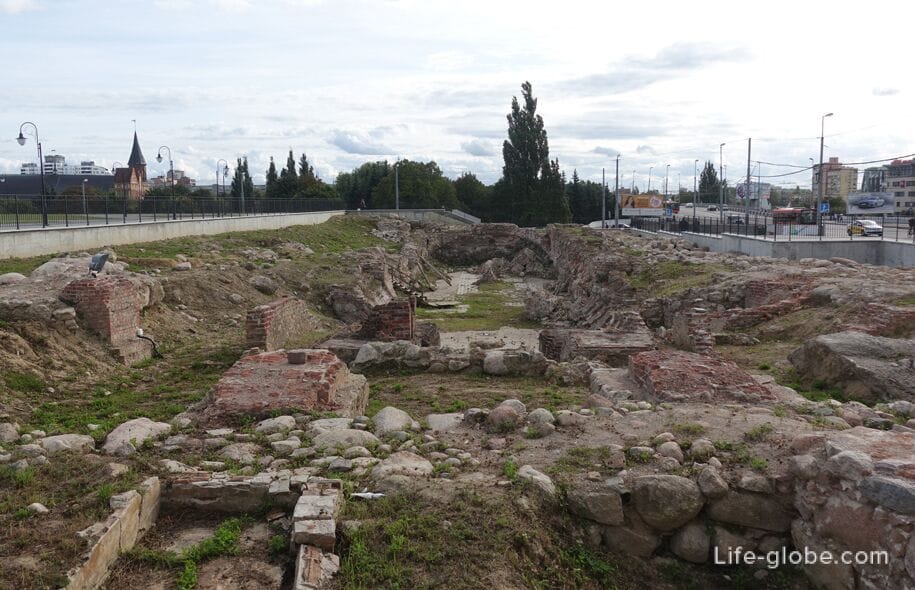
- The "House of Soviets" is the most famous Soviet "unfinished" in Kaliningrad, the construction of which began in 1970.
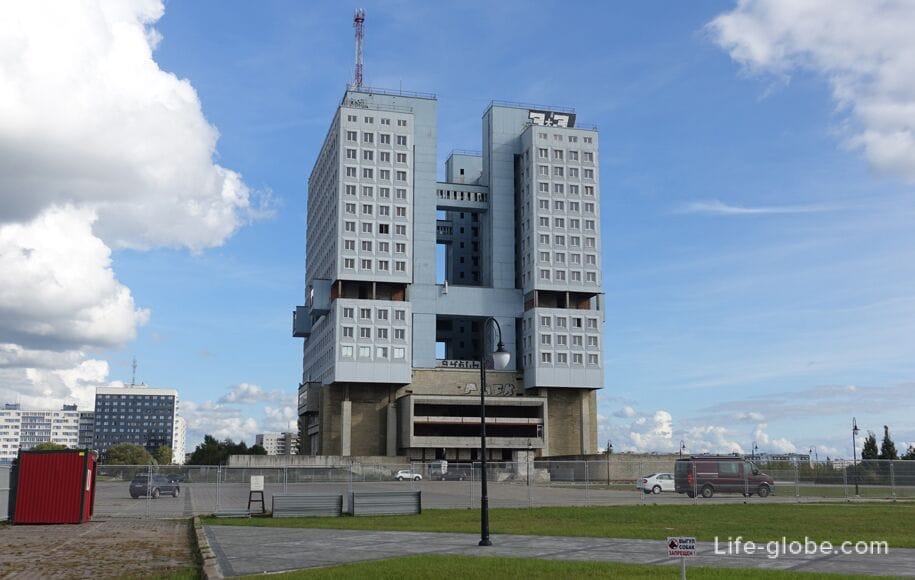
Monument to Immanuel Kant
The monument to I. Kant is notable for being a copy of the Konigsberg monument and is installed on the original historical pedestal in the center of Kaliningrad.
The monument was originally cast in 1857 in Berlin and installed on a high pedestal in Konigsberg. The monument itself was lost during World War II, but the pedestal has been preserved.
Today, a bronze copy of the monument to Kant, cast in 1991 in Berlin, is installed on the old historical Koenigsberg pedestal.
The monument is located in the park on Universitetskaya Street, 2. More about the monument And .Kant...
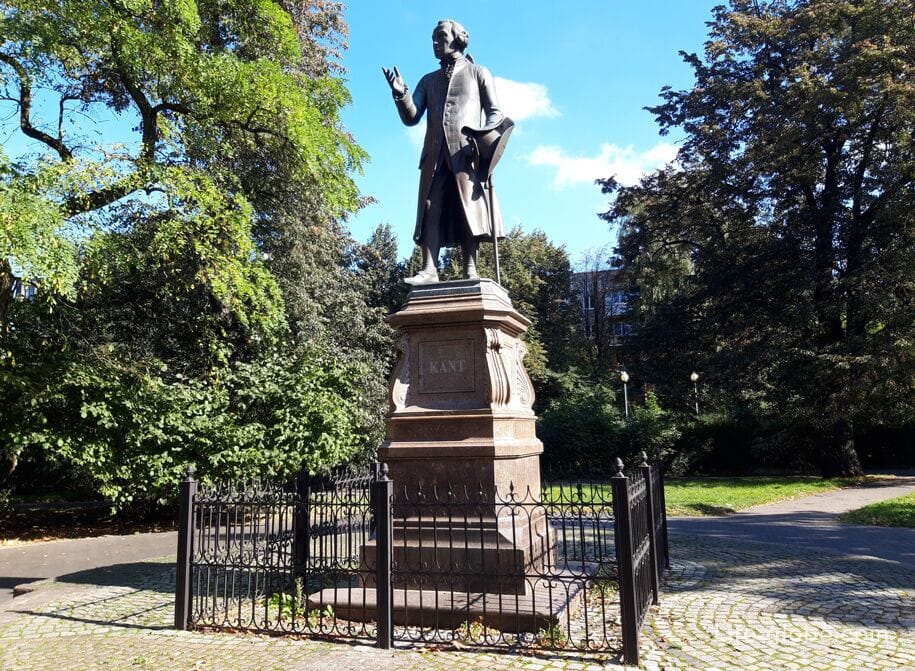
Peter the Great Embankment and the World Ocean Museum
Peter the Great Embankment is located in the center of Kaliningrad, on the north side of the Pregolya River, near Kant Island and the Cathedral.
Initially, there was a port near the embankment. The port facilities in Konigsberg have been built since the 17th century. They often burned, then rebuilt and changed.
The most popular and interesting part of the Peter the Great embankment is the embankment of the Historical Fleet, which is equipped with gazebos, places for walking and recreation, there are historical and educational exhibits, and museum-equipped vessels that are part of the World Ocean Museum complex are moored at the quay of the embankment.
On one of the museumized vessels - the vessel "Vityaz", there are guest cabins "Vityaz" in which, if desired, you can stay.
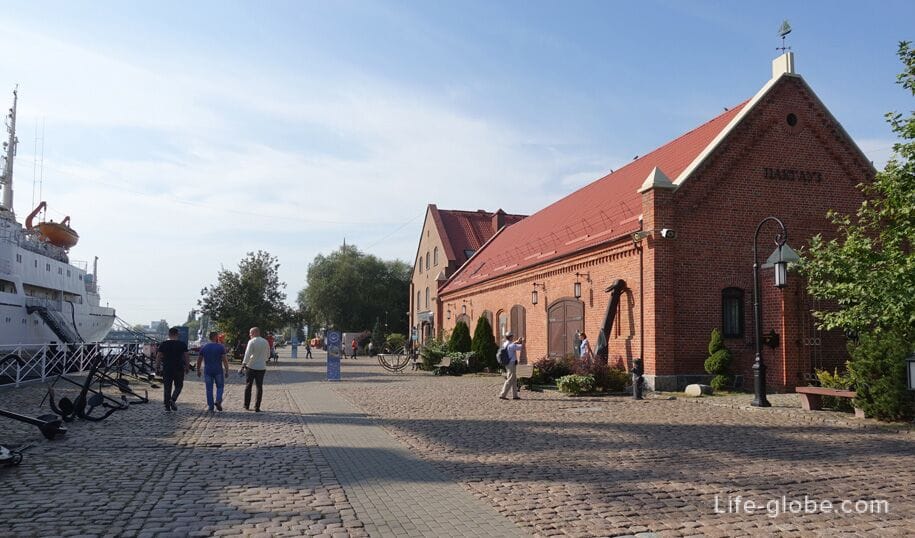
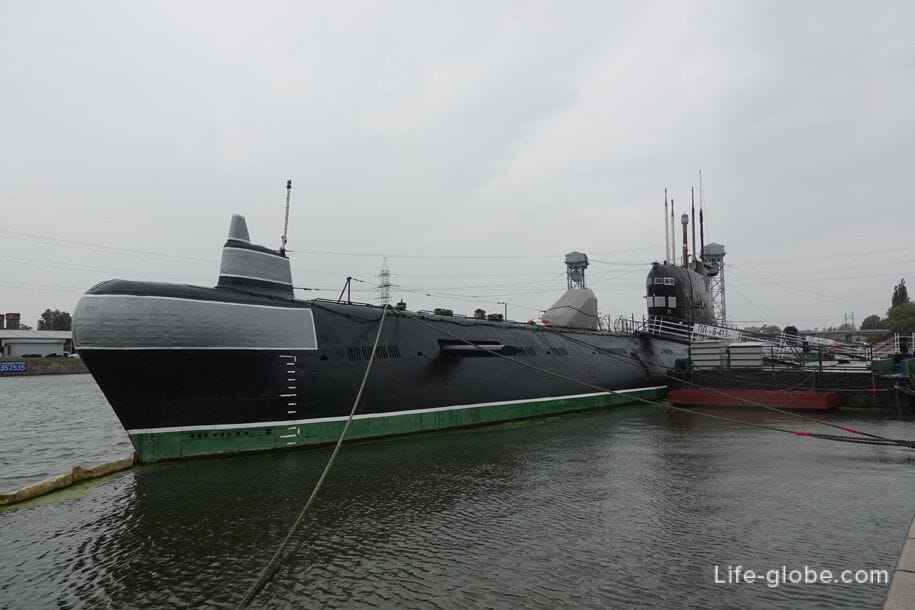
Other embankments of Kaliningrad
In addition to the embankments of Peter the Great and Veterans (Fish Village), in the center of Kaliningrad, along the Pregolya River, there are several more gentrified embankments.
Along the embankments there are places for walking and recreation, bike paths run.
These are such embankments as:
- admiral Tributs embankment;
- the embankment of General Karbyshev. There are children's and sports grounds on the embankment;
- Veterans Embankment, which runs along the river from the High Bridge in a south-easterly direction (towards the Second Overpass Bridge).

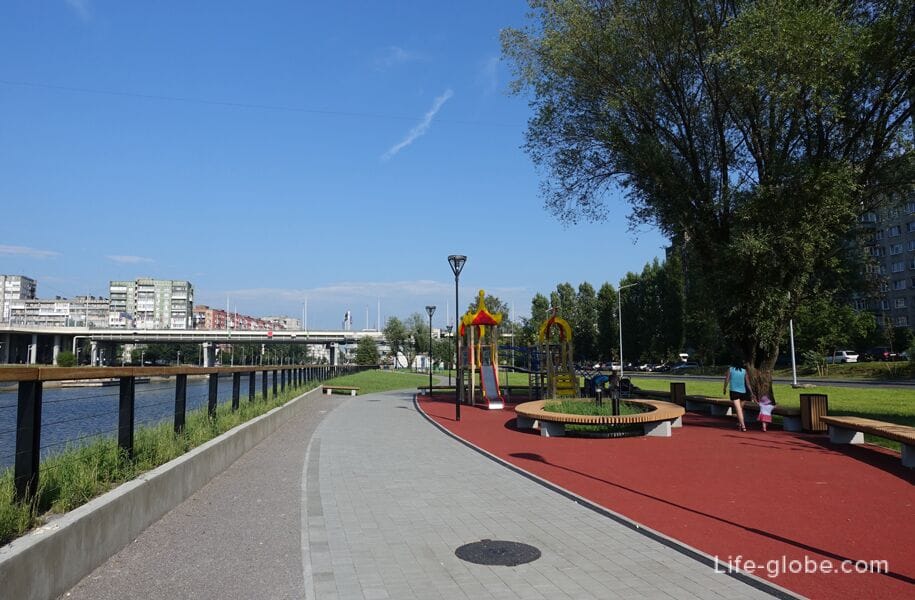
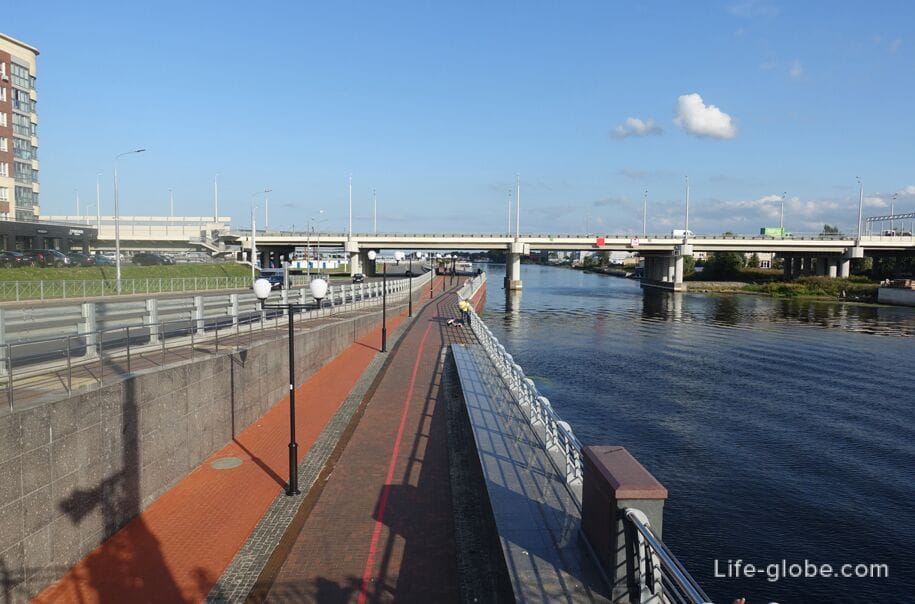
Memorial sign to Baltic sailors
The memorial sign was erected in 1978 in honor of the Baltic sailors who participated in the East Prussian operation during the Great Patriotic War.
The monument is a torpedo boat mounted on an inclined concrete pedestal and rushing nose up, which creates an imitation of a wave and a boat in motion, respectively.
The memorial sign is located between Moskovsky Prospekt, Oktyabrskaya Street and the embankment of the Pregolya River. Learn more about the memorial sign...
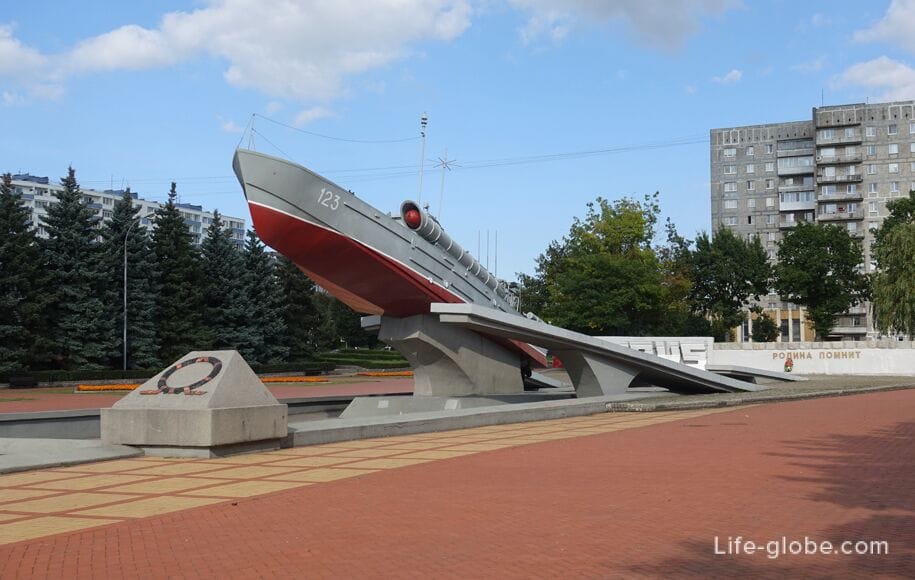
Lower Lake
The Lower Lake or Lower Pond (Castle Pond) is one of the oldest structures of Konigsberg that have survived to the present day.
The area around the Lower Lake is considered a green relaxation area.
The pond is crossed by several bridges. There is a boat station on the lake during the summer season. Swans and ducks live in the lake.
There are places for walking and relaxing around the lake, there are monuments, the 5-star Crystal House Suite Hotel & Spa and the "Castle Pond Cascade" - a water cascade built in Konigsberg in the 1929-1930s and feeding the Lower Lake from the Upper Lake. Learn more about the Lower Lake...
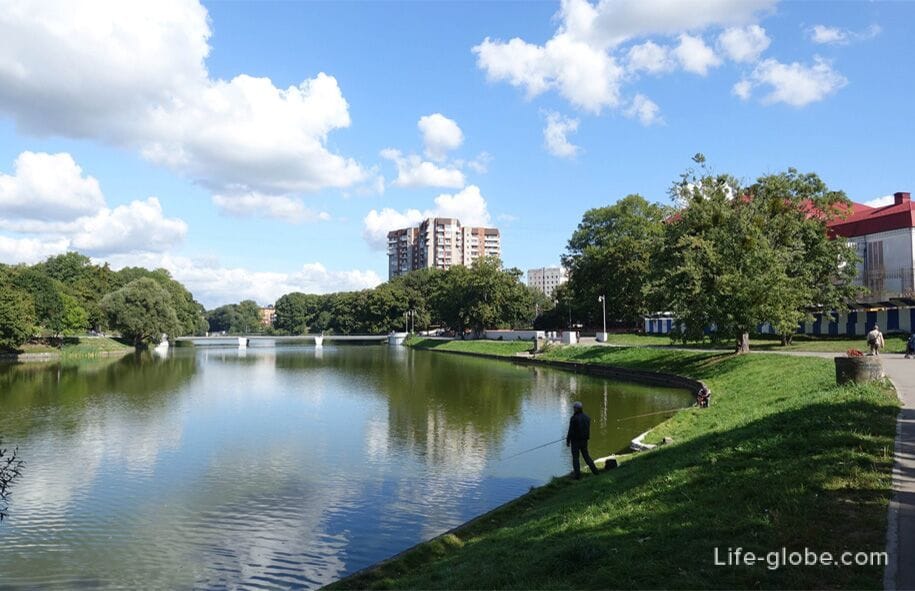
Upper Lake
The Upper Lake or Upper Pond is a reservoir of artificial origin and is particularly popular for walking and recreation among citizens and guests of the city.
Along the lake runs a gentrified embankment with a bike path, there is a 4-star Mercure Kaliningrad hotel, residential buildings, bridges, playgrounds and sports grounds, recreation areas, Yunost Park, a boat station and several historical attractions. Learn more about Lake Superior...
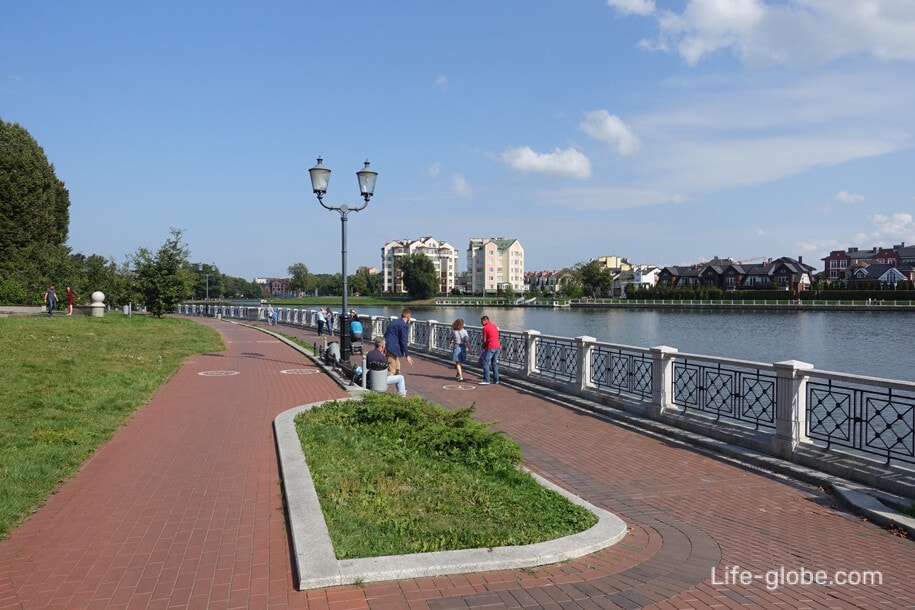
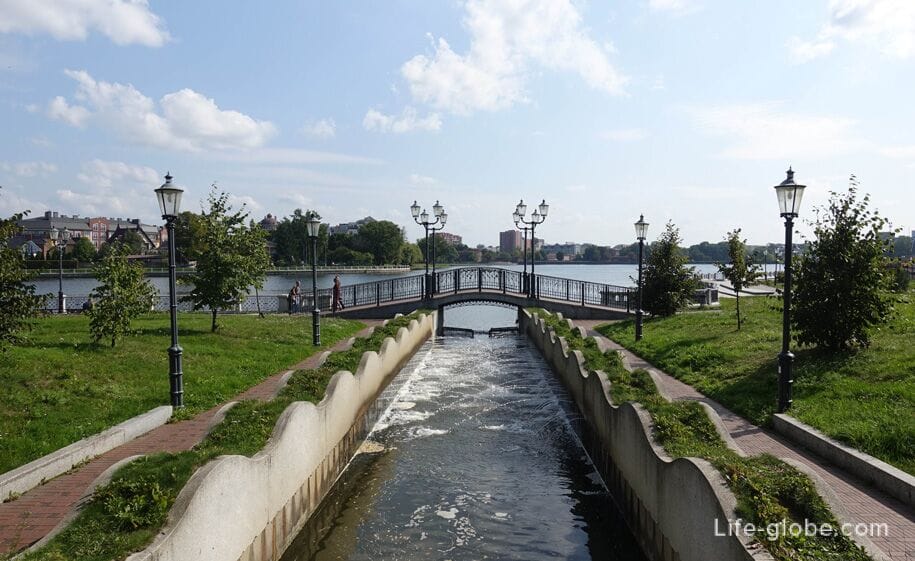
Yunost Park
According to visitors, the Yunost Park is considered one of the best parks in the city for family recreation and entertainment.
On the territory of the Park there isan amusement Park for children and adults, a Ferris wheel, trolls, boat station, 5D cinema, winter indoor ice rink Ice arena, go-kart, adventure Park, trampolines, a "House upside down", the pond area for walking and recreation, centre for the development of interpersonal communications, as well as a cafe and a food court.
The park is located at the intersection of Telman, Azovskaya, Zemelnaya and Gorky streets. More about Yunost Park...
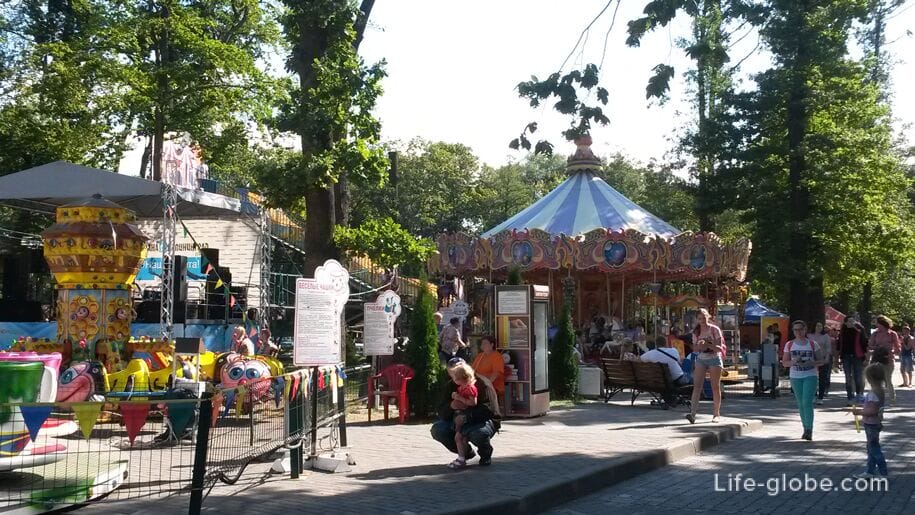
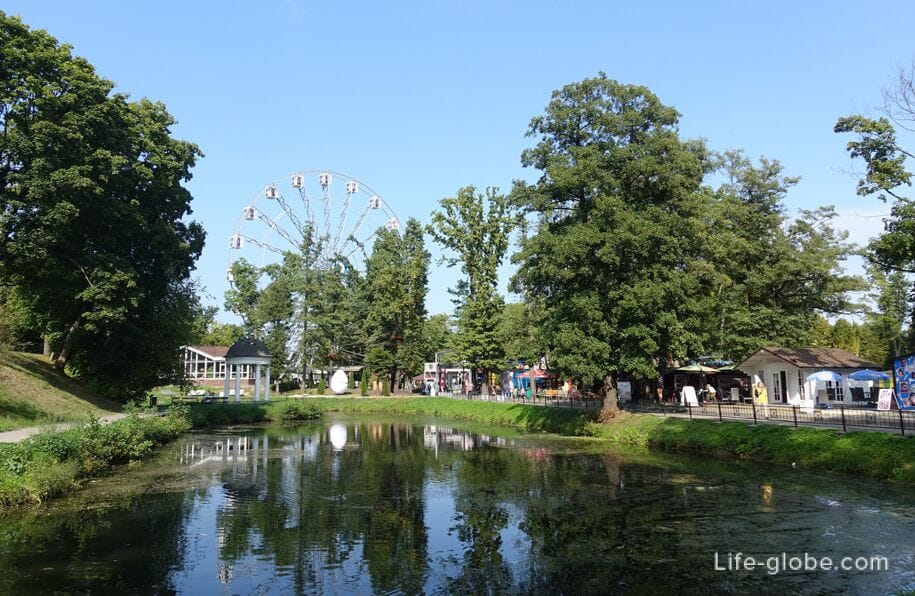
Maraunenhof district
Maraunenhof is a historical district of Kaliningrad, which was once a suburban quarter of northern Konigsberg.
The property in the Maraunenhof area has been located in a forest area since 1571. The district finally emerged and began to develop at the beginning of the 20th century.
In the Maraunenhof area, mainly private mansions and elite housing were built, either in the Art Nouveau style or in the style of a country type, with the architecture of a rural German house.
Currently, the Maraunenhof district is a remnant of the historic German quarter, with cobblestone streets and still preserved, albeit few, houses of the former Konigsberg. More about the Maraunenhof area...
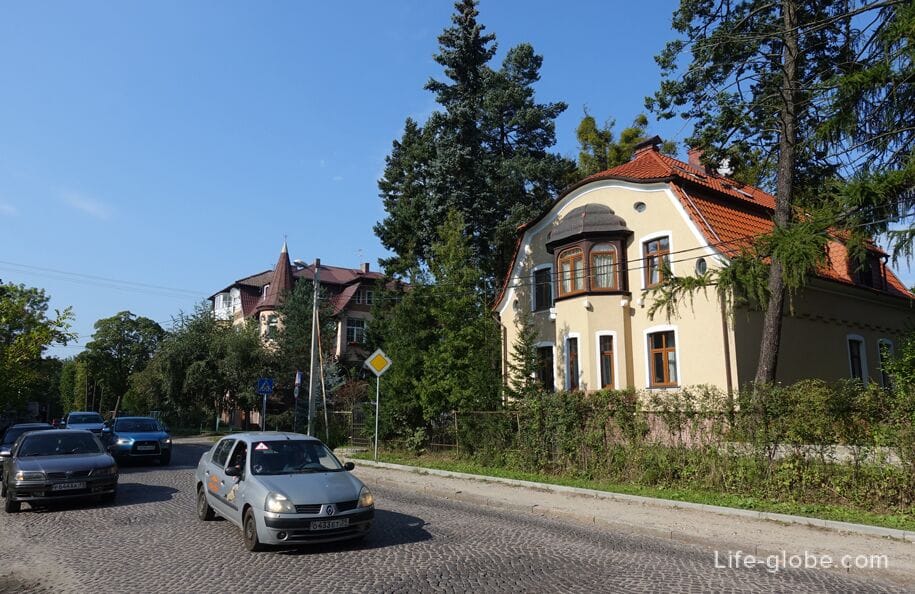
Church of St. Alexander Nevsky
The Church of the Holy Blessed Grand Duke Alexander Nevsky is a Russian Orthodox church, which was founded on July 20, 2008.
On November 16, 2013, the church was consecrated.
The temple was built in a tent-dome style. The five-domed temple has a high central tower and a snow-white appearance.
The interior of the temple is characterized by a bright painting of the walls and ceiling.
The address of the temple: Alexander Nevsky Street, 8. More about the Church of St. Alexander Nevsky...
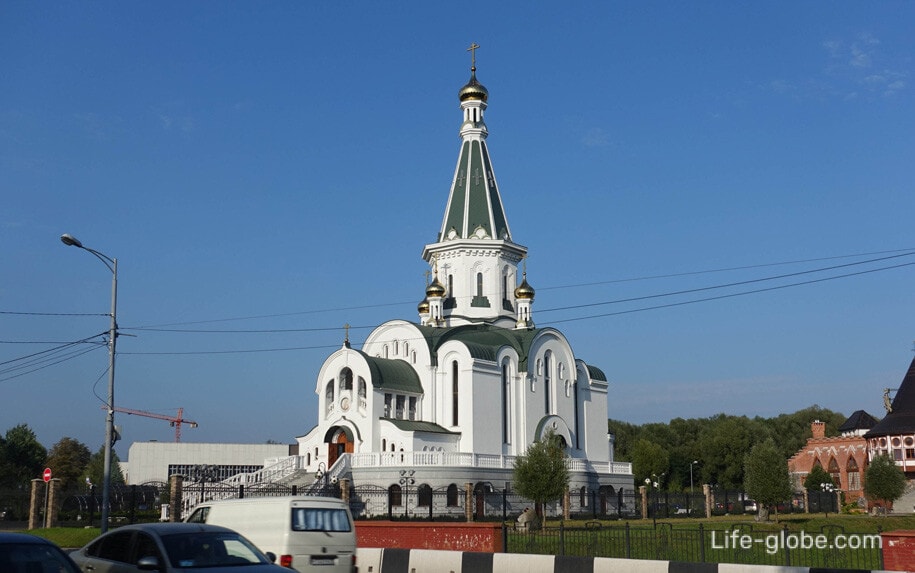
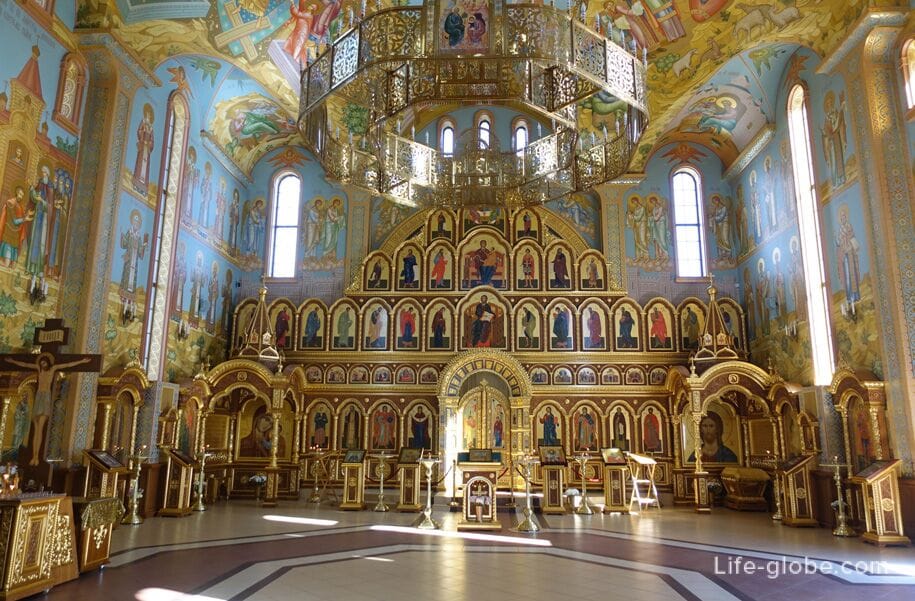
Marshal Vasilevsky Square
The full name is Marshal Vasilevsky Memorial Square. The memorial is dedicated to the heroes of the assault on the fortress city of Konigsberg, designed by architects A.D. Tishin and G.S. Simanovich.
The center of the square is decorated with a monument to twice Hero of the Soviet Union, Knight of the Order of Victory, Marshal of the Soviet Union - Vasilevsky A.M.
Along the perimeter of the square there are curbstones with memorial plaques with the names of Heroes and twice Heroes of the Soviet Union who participated in the storming of Konigsberg.
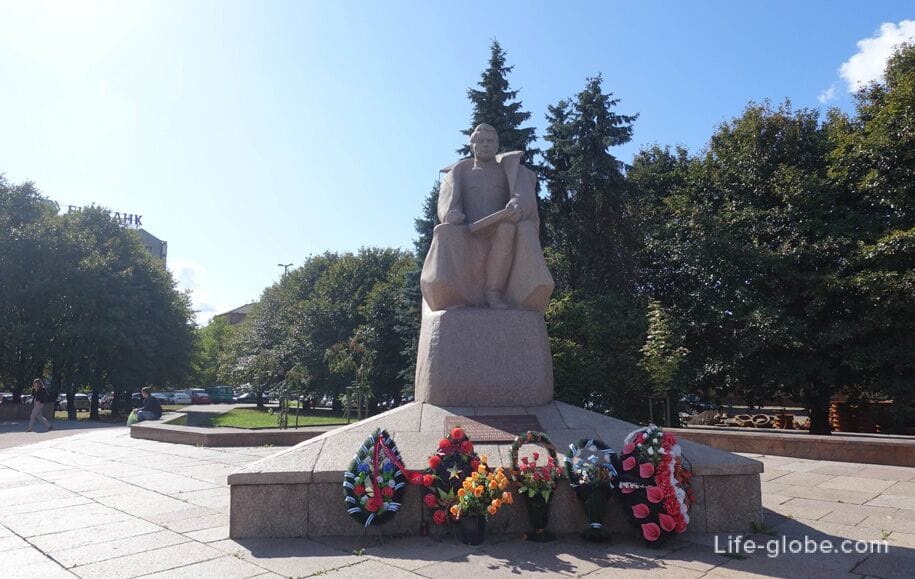
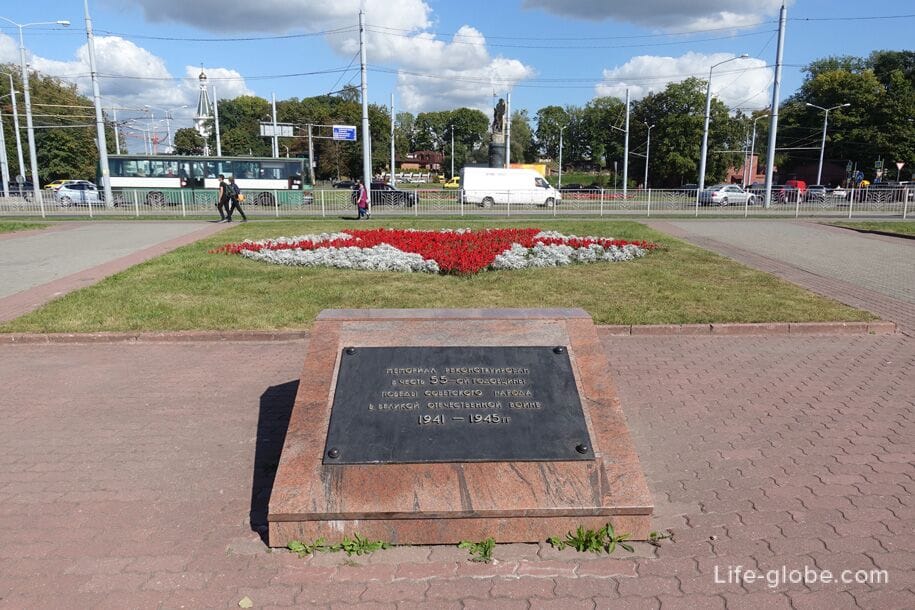
Monument to Alexander Nevsky
In the center of the roundabout of Marshal Vasilevsky Square stands a monument to the Holy Prince Alexander Nevsky, installed in 2018.
A three-meter bronze statue stands on a rocky surface, which, in turn, is mounted on a high pedestal of dark gray granite. The statue of the great Russian commander "holds" a sword in his right hand, a flagpole in his left, a horned helmet and a sword of the defeated enemy are at his feet, and behind the figure is a cross of worship with canonical bas-reliefs and the Holy Face of Jesus Christ.
The pedestal is decorated with the inscription "Alexander Nevsky" and the image of the Order of Alexander Nevsky.
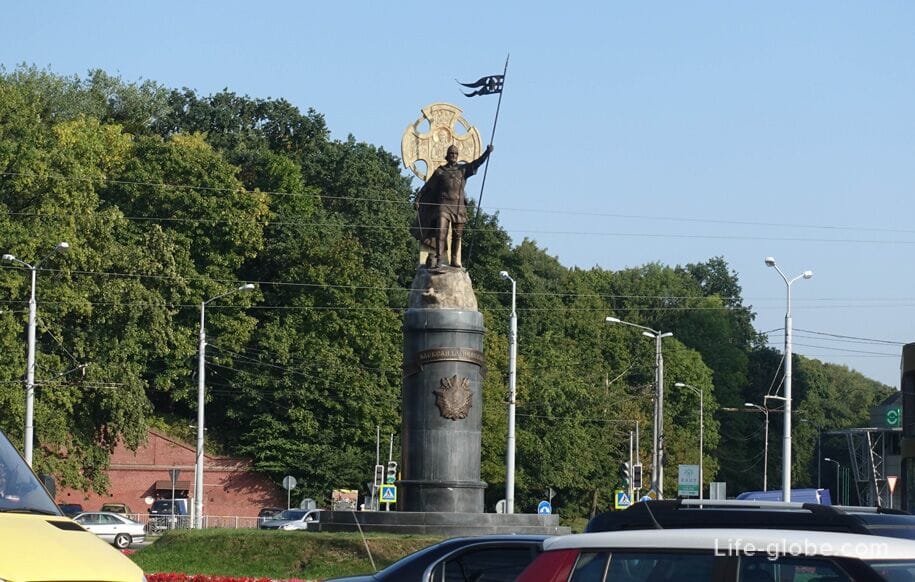
The building of the former Northern Fire Station
The building was built in Konigsberg at the beginning of the 20th century on Wrangel Strasse.
Currently, the building has the status of an object of cultural heritage of regional significance and the Traffic Police Department of the Ministry of Internal Affairs of Russia for the Kaliningrad region is located within its walls.
Building address: Chernyakhovsky Street, 52.

The Palaestra Albertina Building
Initially, the building was the sports palace of the Konigsberg University "Palaestra Albertina", the laying of the first stone of which took place in 1894, and the structure itself was released in 1896.
In August 1944, the building almost completely burned down.
The structure was restored by Komsomol sailors of the Red Banner Baltic Fleet in April 1959 - July 1960. Currently, the Baltflot Sports Club is located in the walls of the house.
On the side facade of the building there is a so-called "mailbox museum", a more accurate and appropriate name is a wall with mailboxes - an open-air museum, which is a wall of the building decorated with mailboxes of various production times, shapes, colors and sizes, including mailboxes from other countries.
The address of the building "Palestra Albertina": Rokossovsky Street, 16/18. More about the mailbox building and museum…
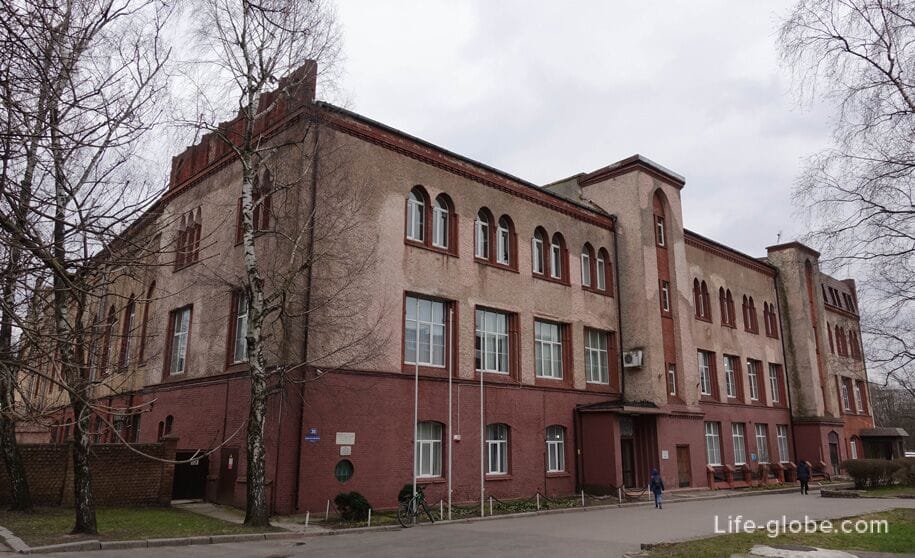
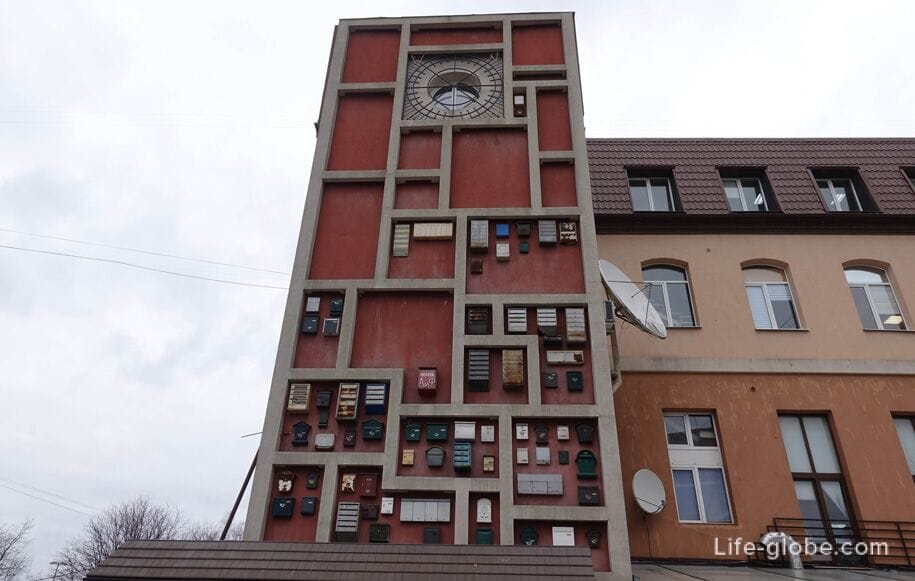
Monument to tank Heroes
The monument to tank heroes was erected in 1980 as a sign of Kaliningrad residents' worship to the feat of tank heroes. The work of architects S.P. Miroshnichenko and V.I. Yakutin.
The monument is a T-34 tank - a direct participant in the battles for the city, mounted on a pedestal.
On the front part of the monument 's pedestal there is a tex: "Your feat is immortal. The memory of you is eternal." On the back of the pedestal there is a text: "During the storming and capture of the fortress city of Konigsberg on April 6-9, 1945, Soviet tank soldiers showed unparalleled heroism."
The monument is located on General Sommer Street, the intersection with Rokossovsky and Minskaya streets.
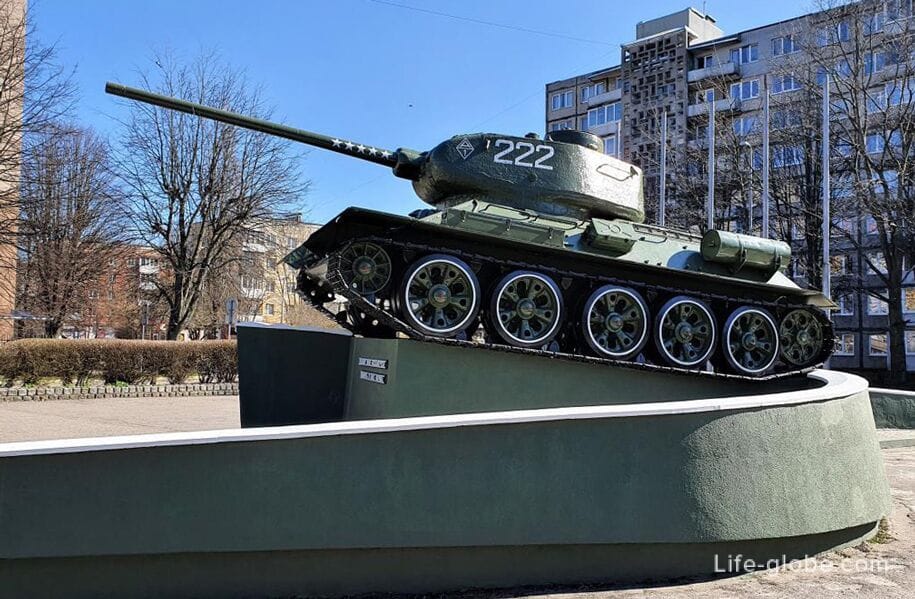
Fortifications of Konigsberg - Kaliningrad
During the history, two protective belts (rings) were created around Konigsberg, surrounding the entire city with fortifications along a circular perimeter:
- The second fortification (defensive belt), which included: ramparts (earthen embankment), ditches, defensive barracks, bastions, Fort Friedrichsburg, defensive towers and walls, barracks and entrance gates to the city;
- the outer protection belt, located more remote from the city and included a ring of forts that were used until the end of World War II.
After the Second World War, some of the objects of fortifications were restored and museums, art spaces, restaurants or shops are located in them today.
At present, the recommended route "Kaliningrad fortification" has been laid out in Kaliningrad, taking a walk along which you can see all the preserved, now reconstructed, remains of former fortifications: city gates, gates of the fortress-fort Friedrichsburg, towers, part of the wall, reduits of bastions, Lithuanian rampart, ravelins and barracks. Learn more about the route and objects "Kaliningrad fortification"...
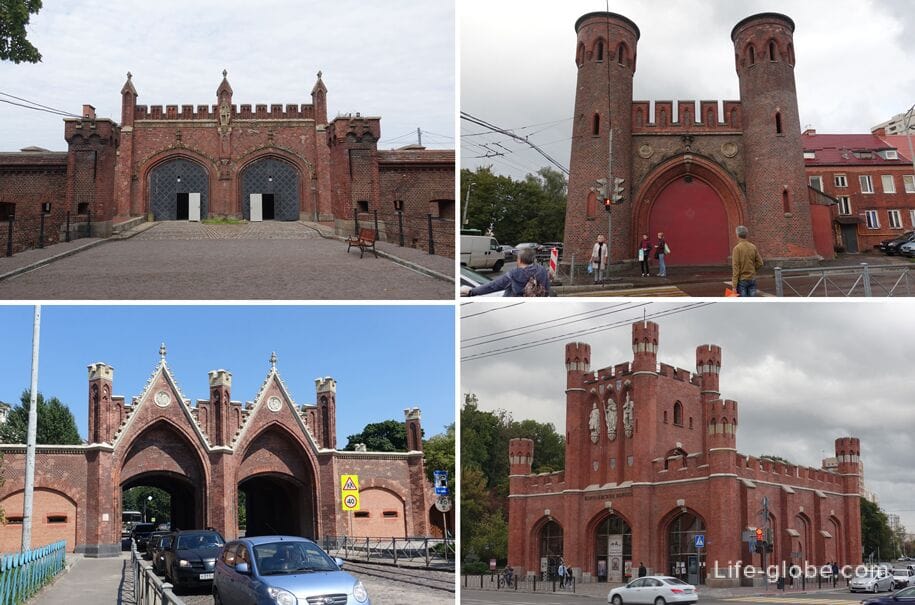
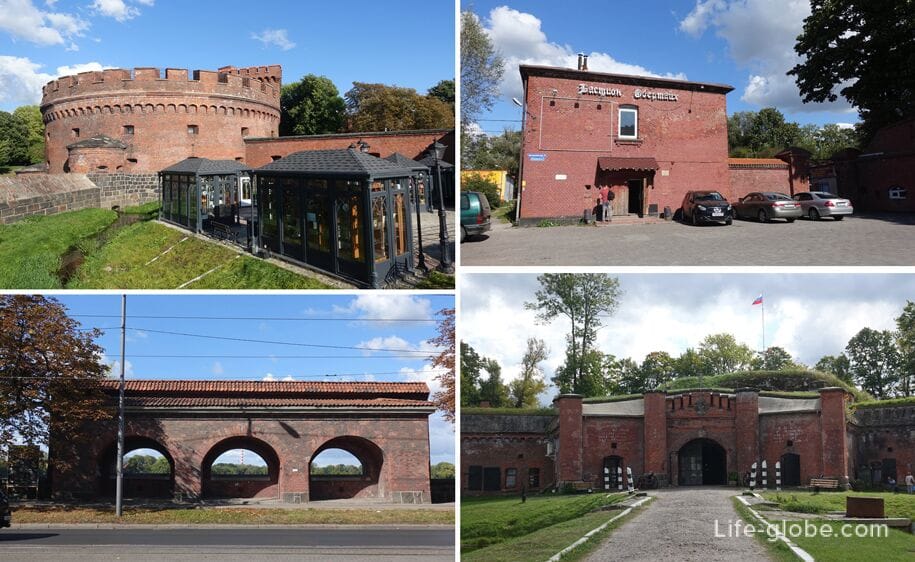
Kreuz-pharmacy
The building was erected in Koenigsberg in 1900-1905 (according to some sources in 1888) in the Art Nouveau style along Koenig Strasse.
During its German history, the building has changed several owners, the most famous of whom was the pharmacist and Doctor of Sciences Adolf Petrenets.
In the post-war years, residential apartments were located in the building, and thanks to the preserved German inscription "Kreuz-Apotheke", the corresponding name was assigned to the building - "Kreuz-pharmacy".
The house was resettled in 1987 for major repairs, which never took place, the building continued to deteriorate and collapse. Then there was a protracted reconstruction in the building.
Today the building has been reconstructed and has a bright mixed facade.
Building address: 51-57 Frunze Street. Learn more about Kreuz Pharmacy...
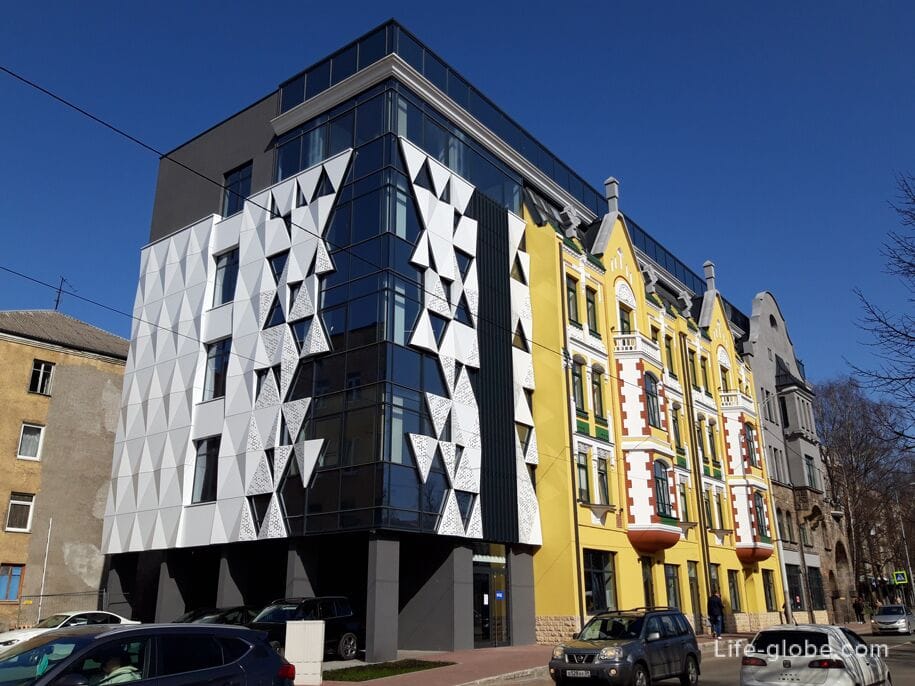
The building of the East Prussian Fire Society
The building of the East Prussian Fire Society was built in Koenigsberg on Koenig Strasse in 1907.
Currently, the building has the status of a cultural heritage site of regional significance and houses a Specialized library for the Blind and commercial premises within its walls.
Building address: 105 Frunze Street.
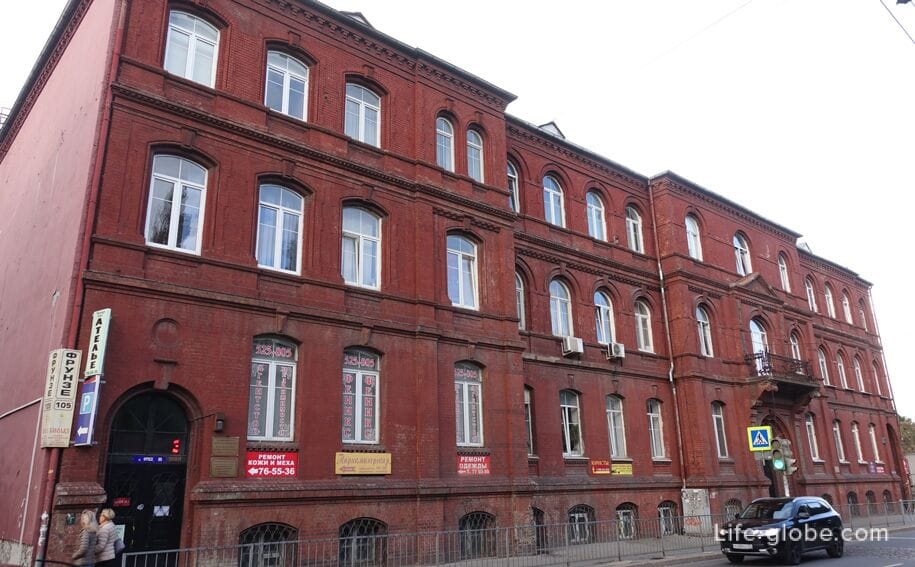
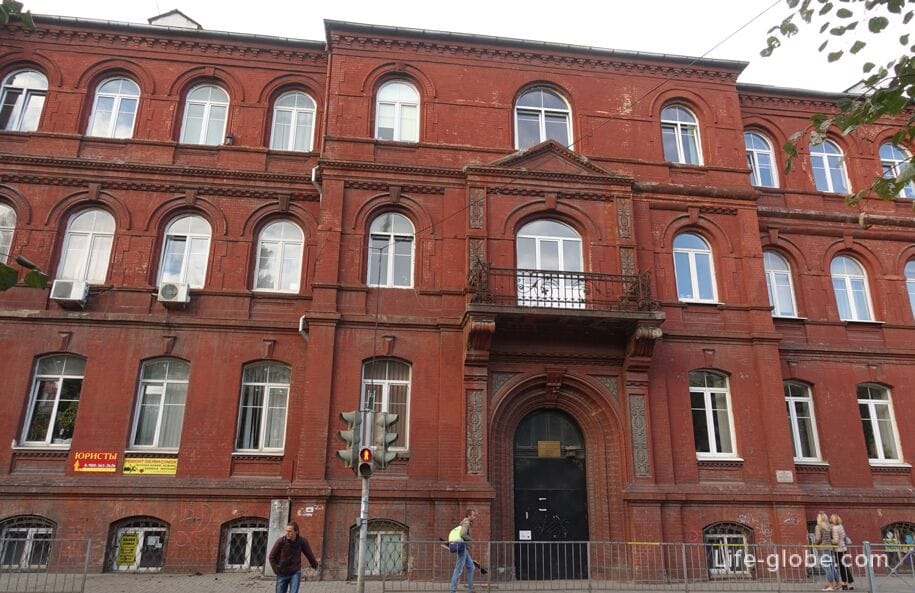
Victory Square
Victory Square is the central square of Kaliningrad and the link of many tourist routes around the city.
On the square: places to relax, several fountains, flowers and low trees with lush crowns, a Triumphal column and the Cathedral of Christ the Savior.
Administrative and commercial buildings are located around the square. More about Victory Square...
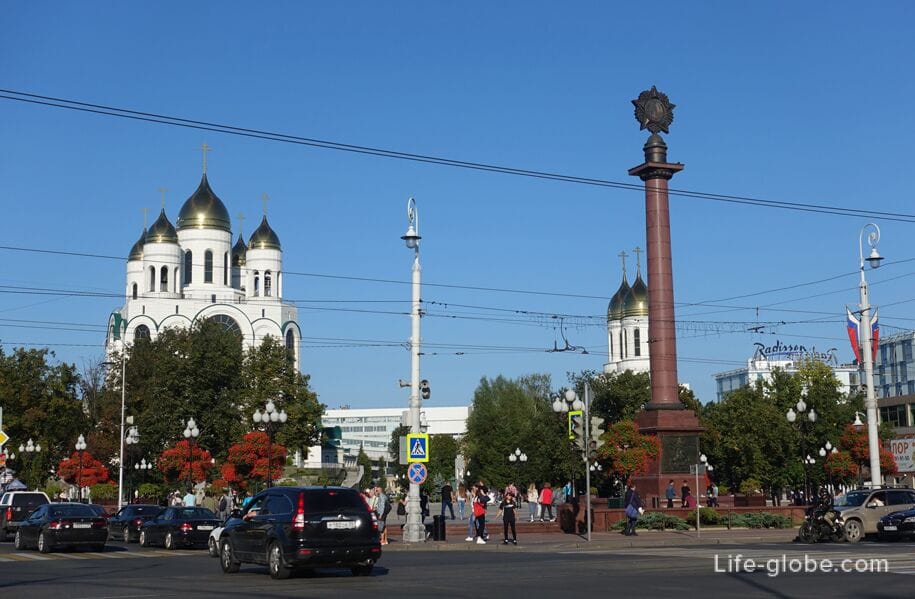
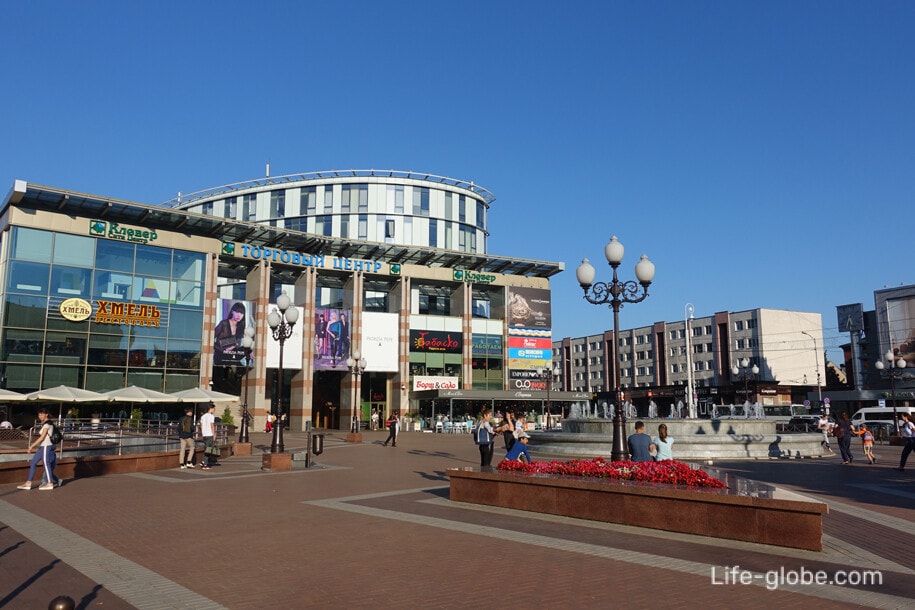
The building of the Police Presidium
The building of the Police Presidium (Polizeipräsidium) was erected at the time of Konigsberg in 1912 on Stresemannstrasse.
The building is made of red clinker brick, in the neo-Renaissance style. It has a quadrangular elongated shape with courtyards. The right wing is decorated with a balcony with a terrace. The main portal is decorated with a relief of shell rock, the central element of which is the head of an ancient warrior.
Building address: Sovetsky Prospekt, 3. Corner building between Handel Street and Sovetsky Prospekt. More about the police presidium building...
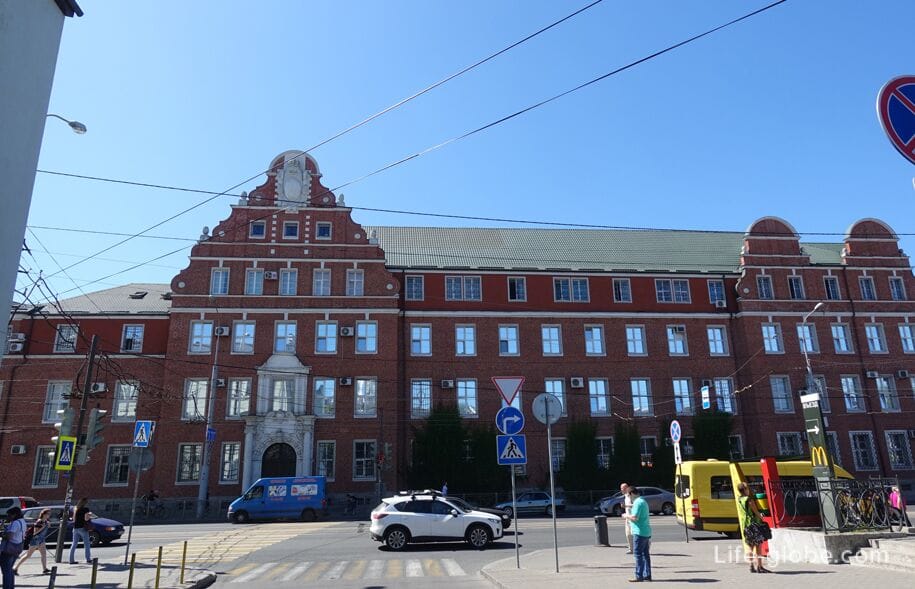
The building of the drama theater
The original building of the theater (Luisen-Theater) was built in Konigsberg in 1911-1912 by architect Otto Walter Kukuk.
In 1923, the building was rebuilt by Dumont du Voitel - the portal with columns was removed and the theater was named "Comic Opera". In 1925, the theater was bought by the administration of Konigsberg, again subjecting it to reconstruction. In 1927, the building was opened as the "New Drama Theater".
During the fighting in 1945, the building was seriously damaged and burned out. Then it was rebuilt using old load-bearing structures and with the addition of the main portal with six Corinthian columns.
The address of the drama theater: Prospekt Mira, 4.
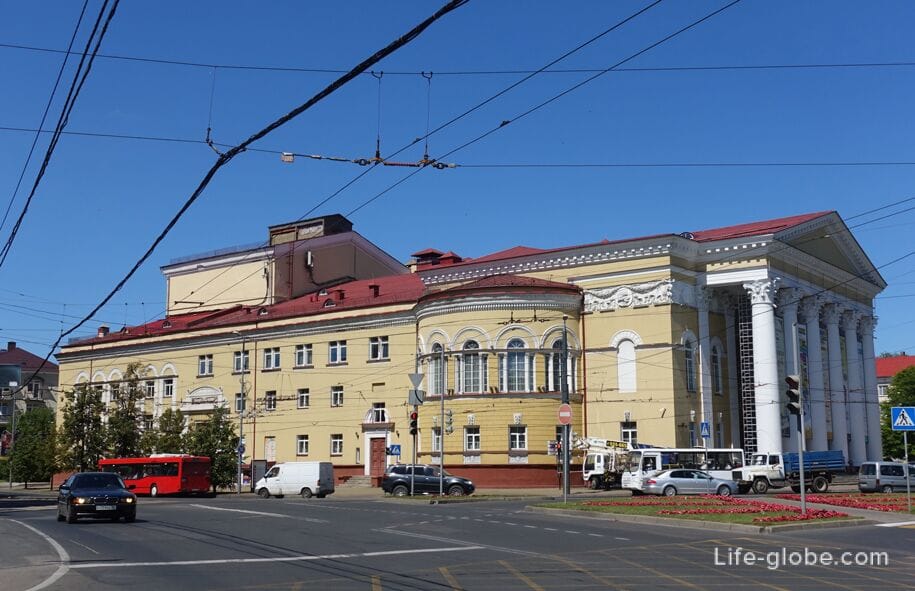
Sculpture "Fighting bison" and the square
The sculpture "Fighting bison" was created by the German animalist sculptor August Gaul in 1911 and installed in Konigsberg on the Hufen Alley on November 12, 1912.
The sculptural composition is mounted on a pedestal and represents two large male bison, cast in life-size bronze, locked in a fight. In front of the pedestal there is a rectangular water tank, and from two holes in the pedestal, covered with stylized shells, small jets of water flow into the bowl.

Now the sculpture is located in a small square between Mira Avenue and Grekova Street.
In addition to the sculpture of bison in the park are also notable: the building of the Supreme Directorate of the Post Office, erected in 1914-1916 and which currently houses the headquarters of the Baltic Fleet; and, a complex of buildings of the former land and administrative court, which were built in 1914. Learn more about the square and the sculpture "Fighting bison"...
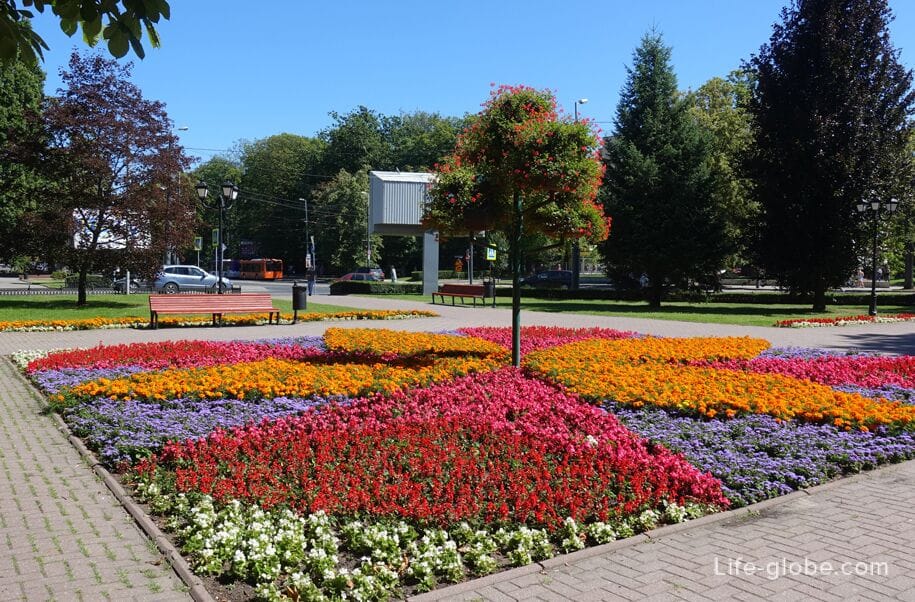
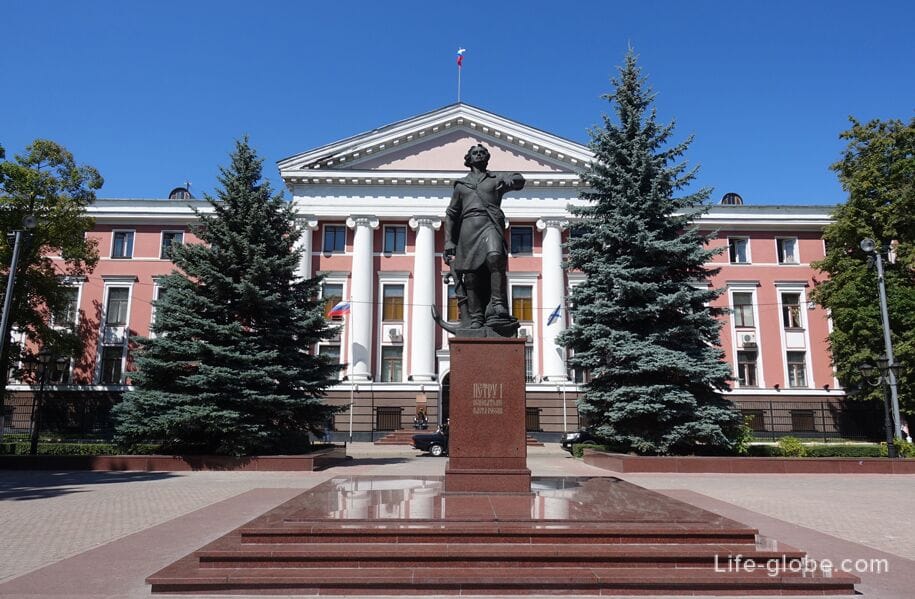
Square of Power Engineers
Energetikov Square is located near the Drama Theater, between Mira Avenue and Teatralnaya Street.
In the square: places to relax, flower beds and, especially noteworthy, the monument to Friedrich Schiller, installed in 1910 at the City Opera House and moved in 1936 to this square (sculptor Stanislaus Gauler, bronze, granite); a musical fountain at the monument to Schiller and the historic building of the labor Exchange built in 1831.
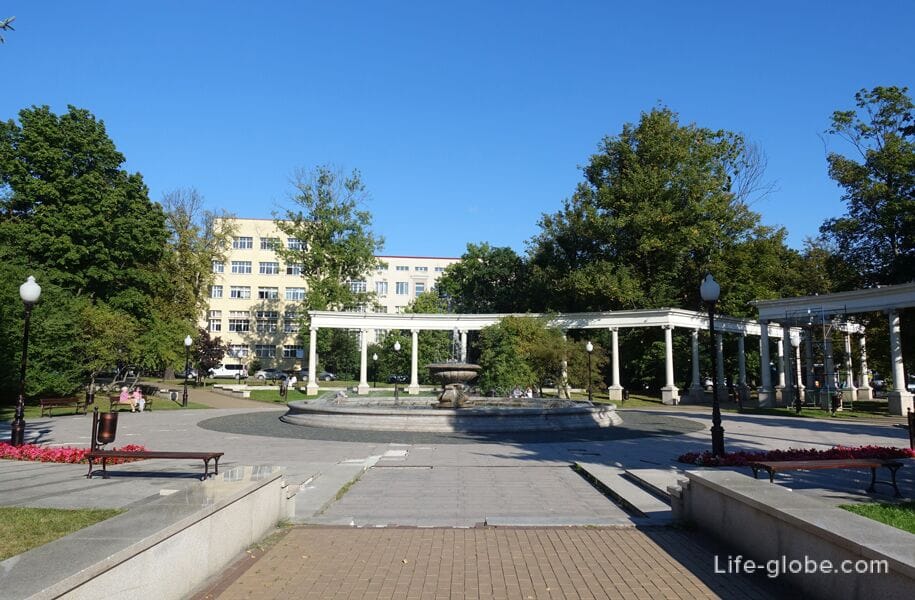

The building of the Financial Administration of East Prussia
The historic building of the Financial Administration of East Prussia, which now houses the Government of the Kaliningrad Region, was erected on the Alta Pillauer Landstrasse in 1928, designed by architect Friedrich Lars.
The building is notable for the concave line of the facade and a large double-leaf entrance door made of pressed copper according to a sketch by Herman Brachert.
Building address: Dmitry Donskoy Street, 1.
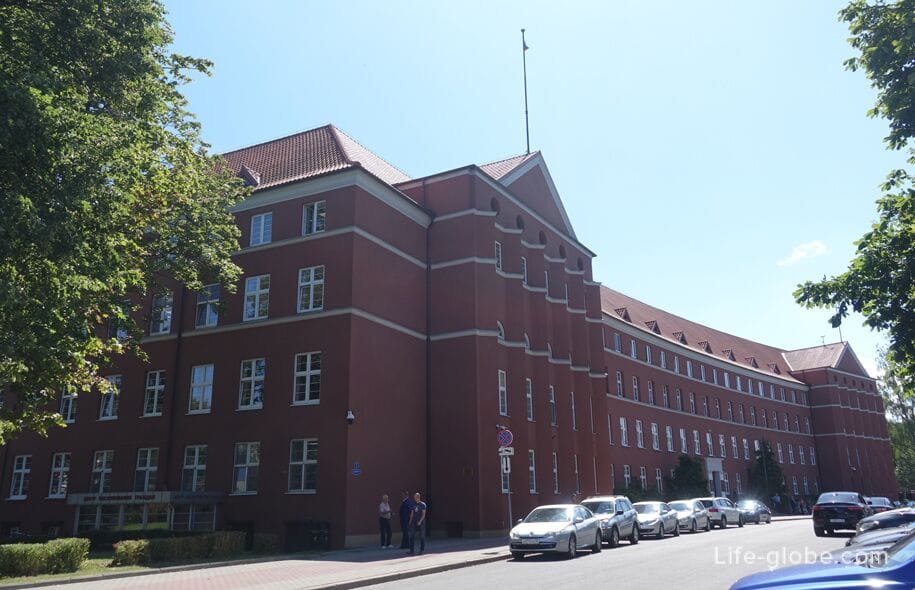
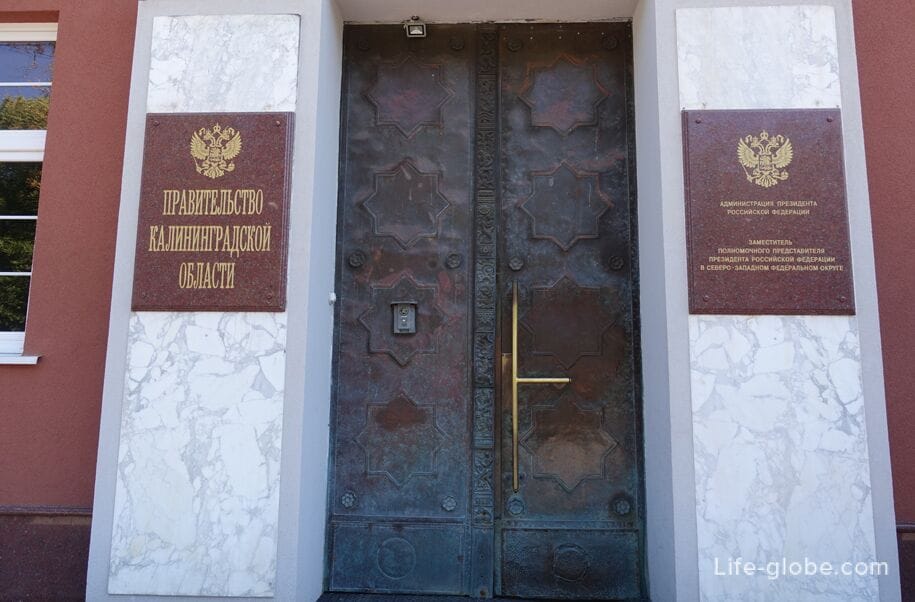
Main streets of the city
Mira and Leninsky Avenues are one of the main, as well as the most visited and interesting streets of the center of Kaliningrad.
Both streets are carriageways, with pedestrian sidewalks on both sides.
Along the avenues there are some of the most significant historical buildings of the city, there are several squares where you can relax, a park, a zoo, a stadium, theaters, fountains, sculptures and monuments, as well as cafes, restaurants and shops.
The following accommodation facilities are located along the avenues: 3-star Hotel Moscow with free private parking, free Wi-Fi, restaurant, bar and family rooms; and, 3-star Hotel Kaliningrad with 2 international restaurants and free parking.
Learn more about Mira and Leninsky Avenues (+ Teatralnaya Street)…
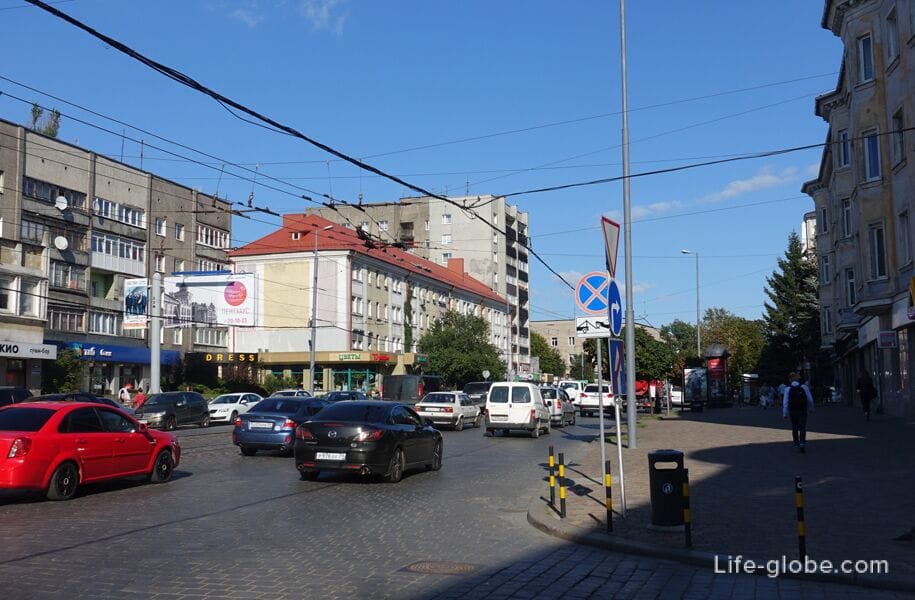
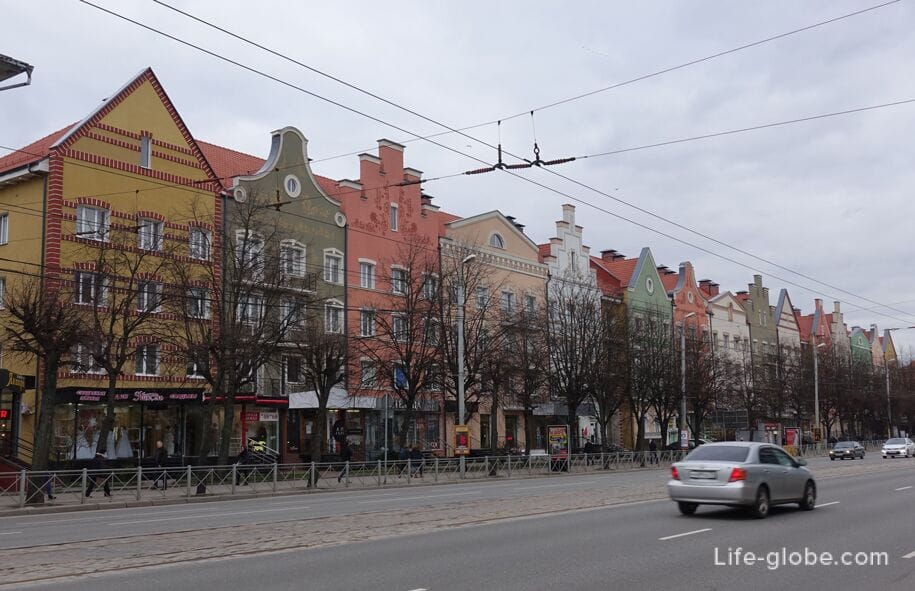
Kaliningrad Zoo
Kaliningrad Zoo is one of the largest and oldest zoos in Russia.
At the moment, the zoo occupies an area of 16.7 hectares, on which there are aviaries with animals, a bird house, a terrarium, an aquarium, an arboretum, sculptures and monuments, a playground, a square with a fountain, as well as recreation areas, gazebos, ponds, cafes and snack bars.
The address of the zoo: Prospekt Mira, 26. Learn more about the Kaliningrad Zoo...
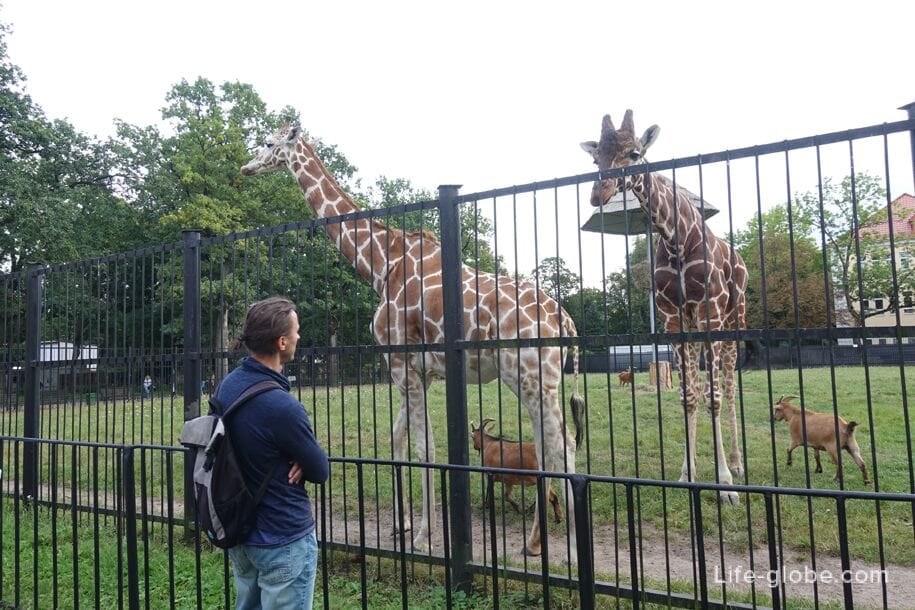
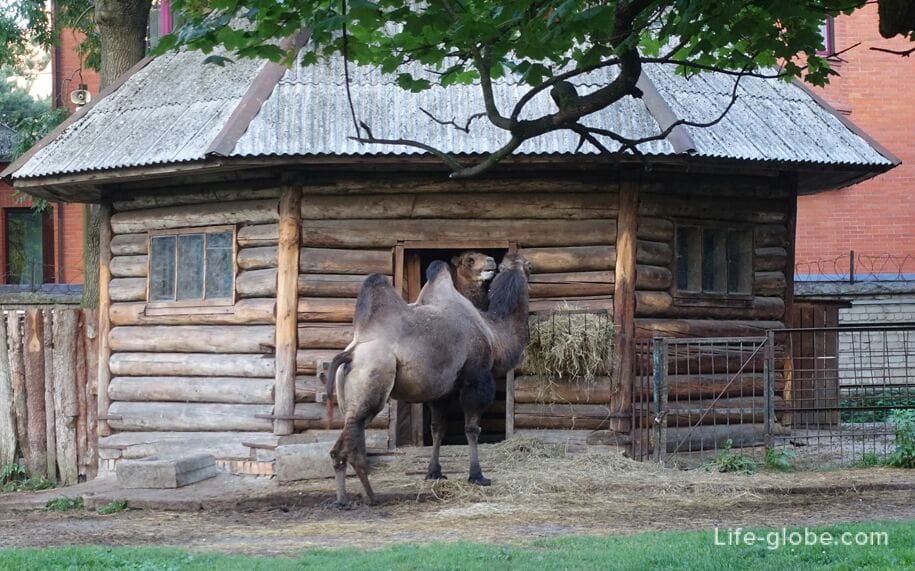
Central Park of Culture and Recreation
The Central Park of Culture and Recreation (formerly Kalinin Park) is one of the most visited parks in Kaliningrad.
Many plants and trees that were planted in the pre-war years have been preserved in the park.
In the park: alleys for walks, places to relax, fountains, a children's area with attractions, kiosks with snacks and food, the church of Queen Louise (now the regional puppet theater), sculptures and monuments.
The main entrance to the park is from Mira Avenue. More about Central Park...
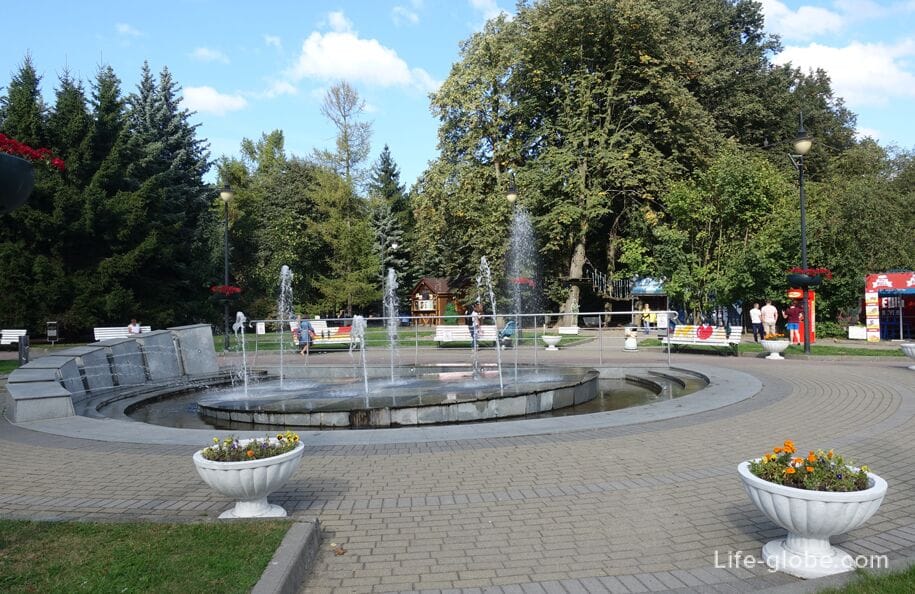
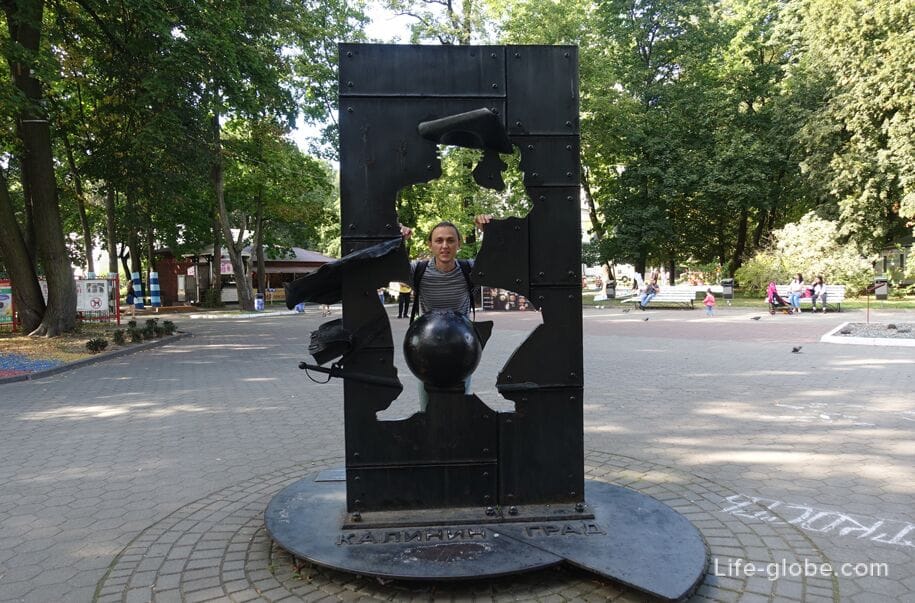
Amalienau district with a Float pond
Amalienau - former prestigious suburban quarter (district) Konigsberg, now part of the Central District of Kaliningrad.
Amalienau was known for its luxury villas, which already at the beginning of the 20th century had gas, electricity, water and sewerage. Villas in the Amalienau area were built for the wealthy class of residents, had unusual and luxurious, at that time, decorations and exterior details.
The current Amalienau is one of the sights of Kaliningrad and a popular tourist route. In Amalienau, you can see some preserved villas from the period of Konigsberg's construction, there is a church, monuments, small squares and quiet cozy streets.
Also in Amalienau there is a small pond - a Float pond or a Bread lake. There is an embankment along the lake, there are places for recreation and a playground. Bridges are equipped across the channels of the pond. More about the Amalienau area...
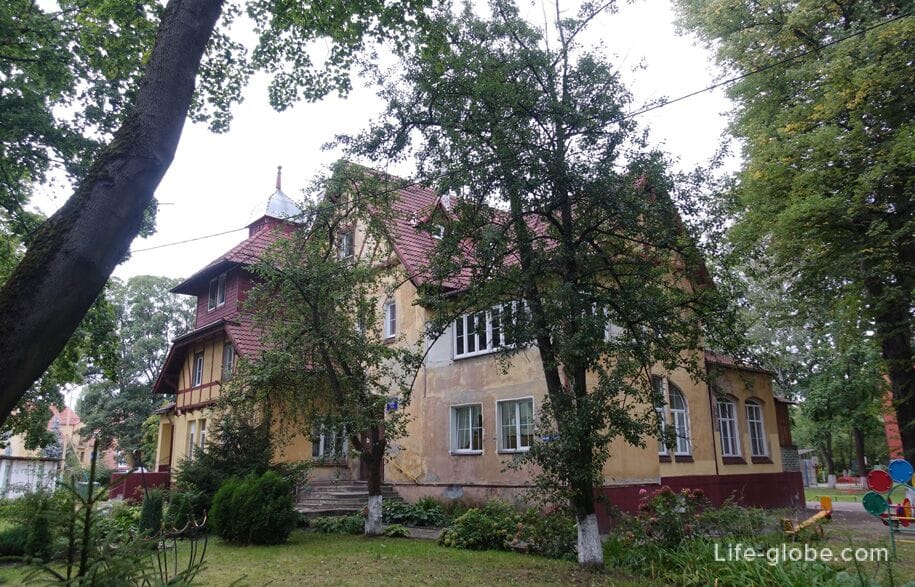
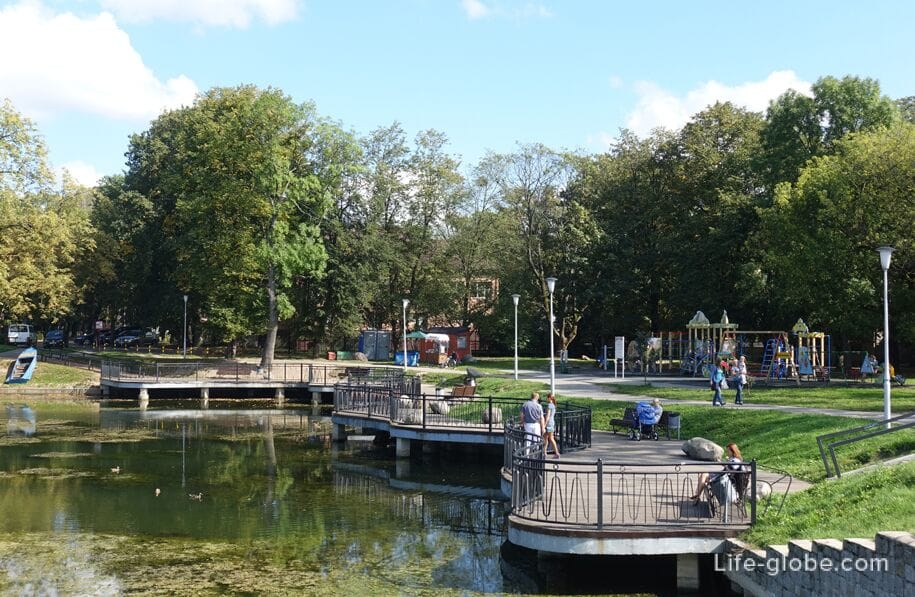
Victory Park
Victory Park, the full name is the park of the 55th anniversary of Victory.
The park was founded by veterans of the Great Patriotic War on May 8, 2000, in honor of the 55th anniversary of the Victory.
Today, the park is an open-air memorial complex with paths for walking and places to relax. More about Victory Park...
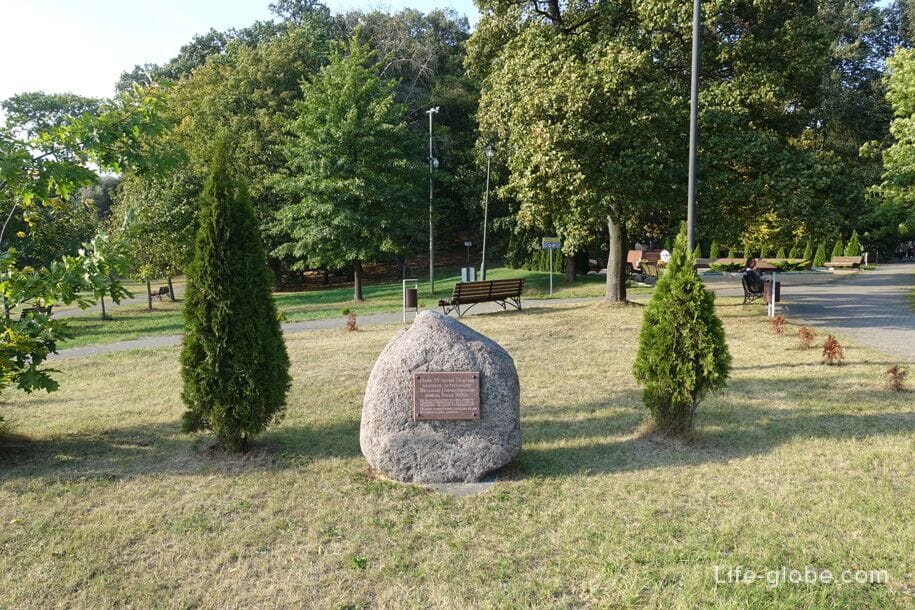
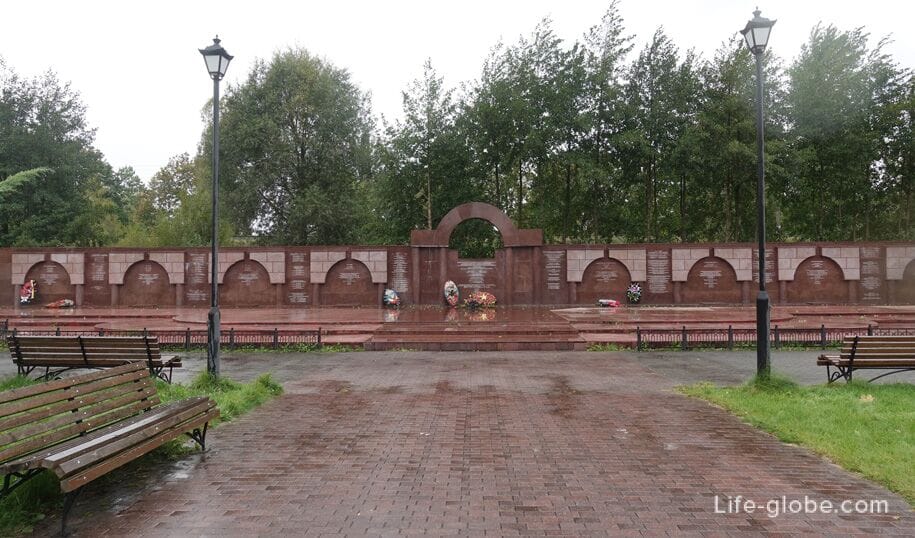
Botanical Garden
The Botanical Garden of the Immanuel Kant Baltic Federal University covers an area of 13.57 hectares. and his collection includes more than 2,500 plants.
The Botanical Garden on its present site was founded in 1904.
On the territory of the botanical garden there are: greenhouses, greenhouses, a pond, a nursery of woody plants, collection areas of herbaceous and woody plants, utility rooms.
Address of the botanical garden: 12 Lesnaya Street.
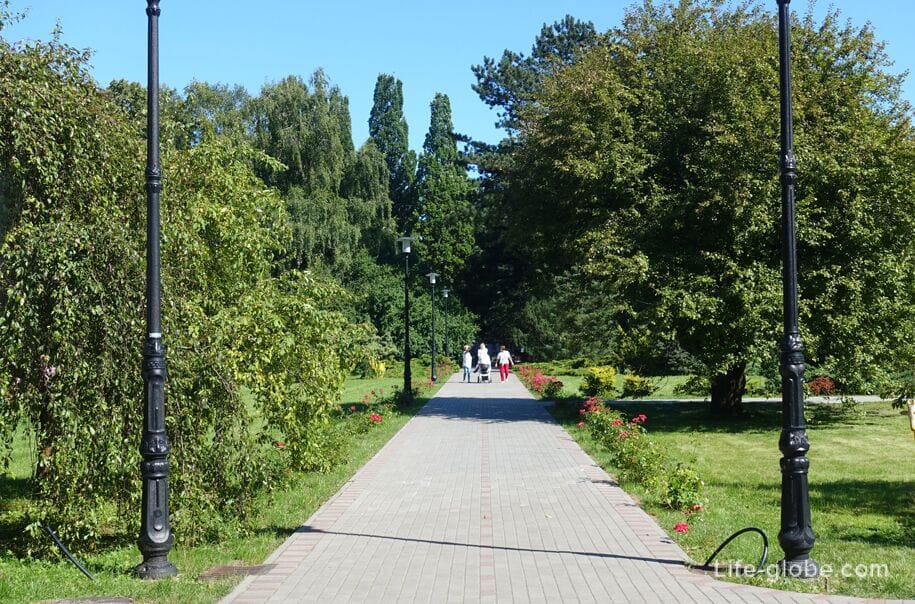
Max Aschmann Park (Lesnoye Lake)
Max Aschmann Park traces its history back to the time of Kenegsberg and at that time bore the German name Max-Aschmann-Park (Max-Aschmann-Park).
Currently, the park is a green area, more like a forest belt (subjective opinion), for walking and recreation.
In the park: paths and paths for walking; there are several lakes, the largest of which is Lake Lesnoye, the territory near which is used by citizens for picnics and recreation; a children's and sports playground. More about Max Aschmann Park...
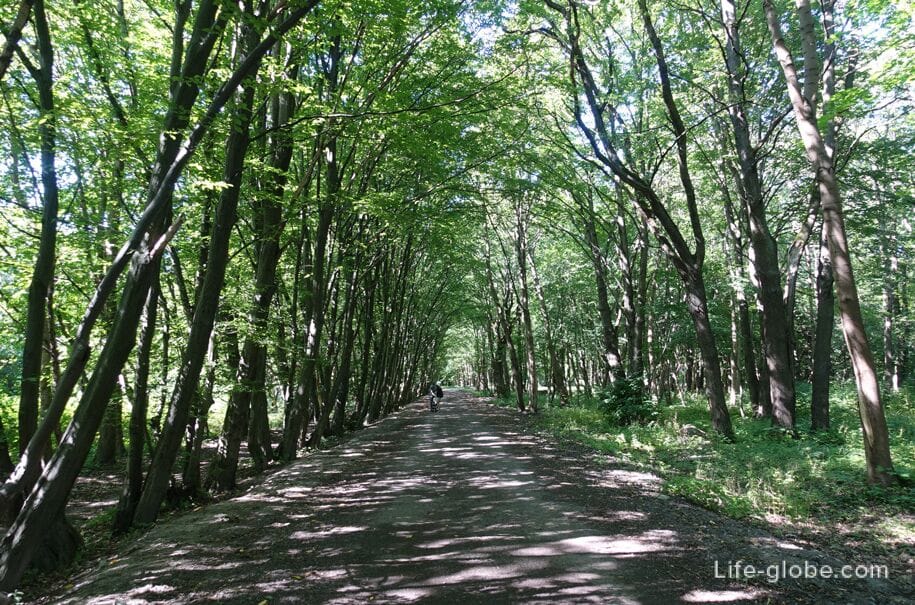
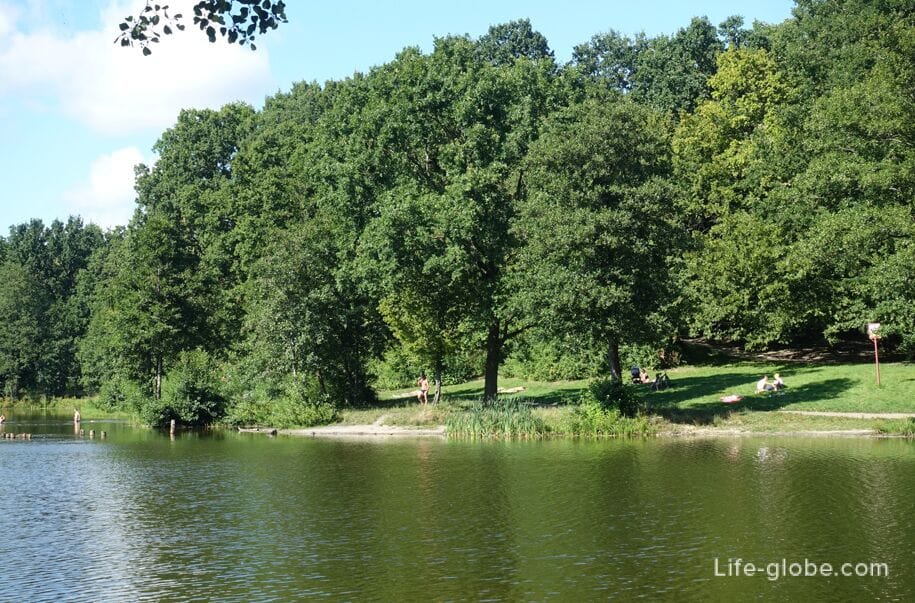
Holy Family Church
The Church of the Holy Family (Kirche "Zur Heiligen Famile") was built in the time of Konigsberg. Currently, it is an architectural monument of regional significance and the concert hall of the Kaliningrad Regional Philharmonic named after E.F. Svetlanov is located within its walls.
The church was built in the Neo-Gothic style in the period from 1904 to 1907. Many elements of the building and its layout were borrowed from the ancient Gothic churches of East Prussia.
During the Second World War, the church suffered only partially.
In 1980, the church was radically reconstructed as a Philharmonic concert hall with 400 seats.
The address of the church: Bogdan Khmelnitsky Street, 63a. More about the Church of the Holy Family...
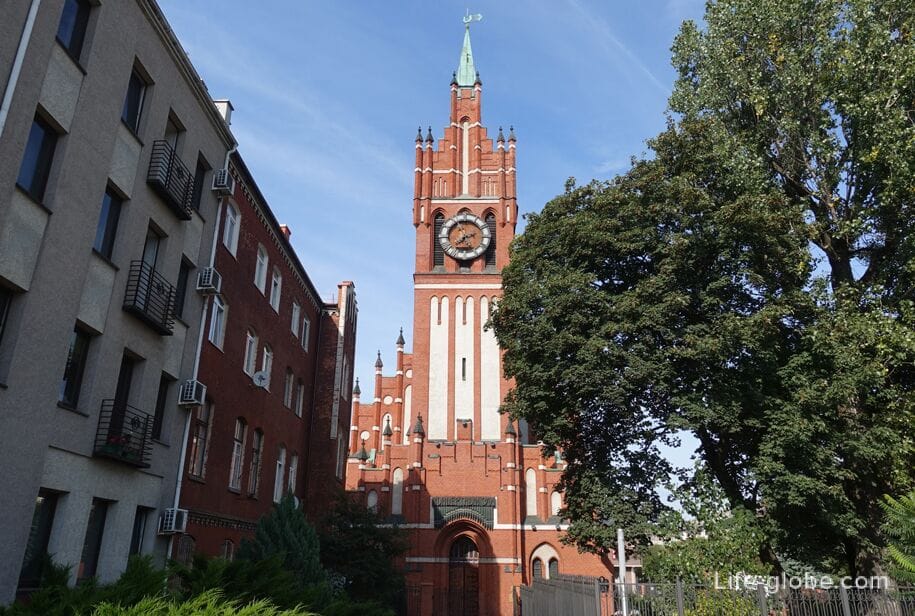

Memorial sign of Soviet-Polish friendship
The memorial sign of Soviet-Polish friendship was made of concrete by sculptor E.A. Popov in 1977 to commemorate cooperation and friendship between the Kaliningrad Region and the Olsztyn and Elblong voivodeships of Poland.
The address of the memorial sign: Olshtyn Lane, 9.
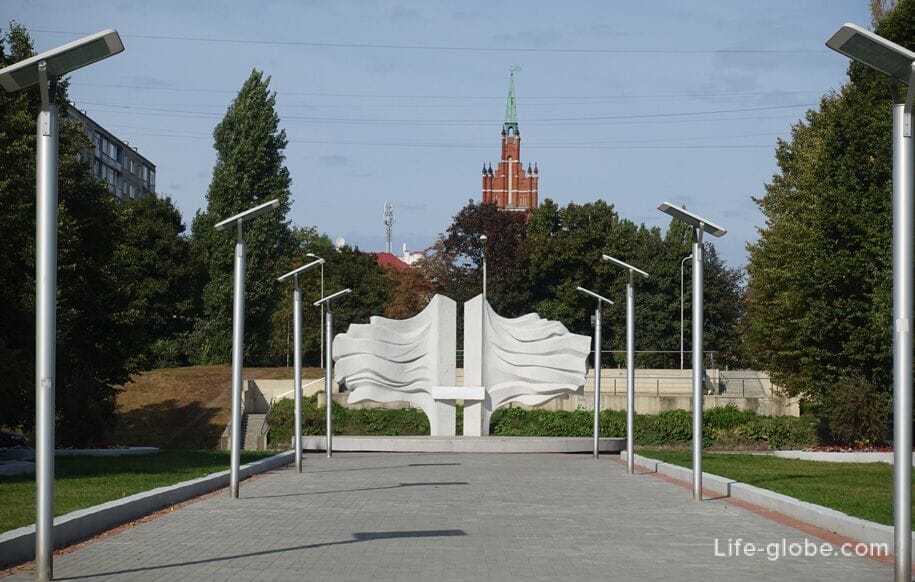
Yuzhny Park
The Yuzhny Park is a green area with alleys and paths for walking, reservoirs (ponds), monuments, historical objects, children's and sports grounds.
In Yuzhny Park there is a miniature park "History in Architecture", where models of the main architectural masterpieces of "big" Russia, made in miniature, are presented.
The Yuzhny Park is located along Kalinin Avenue. More about the Yuzhny Park...
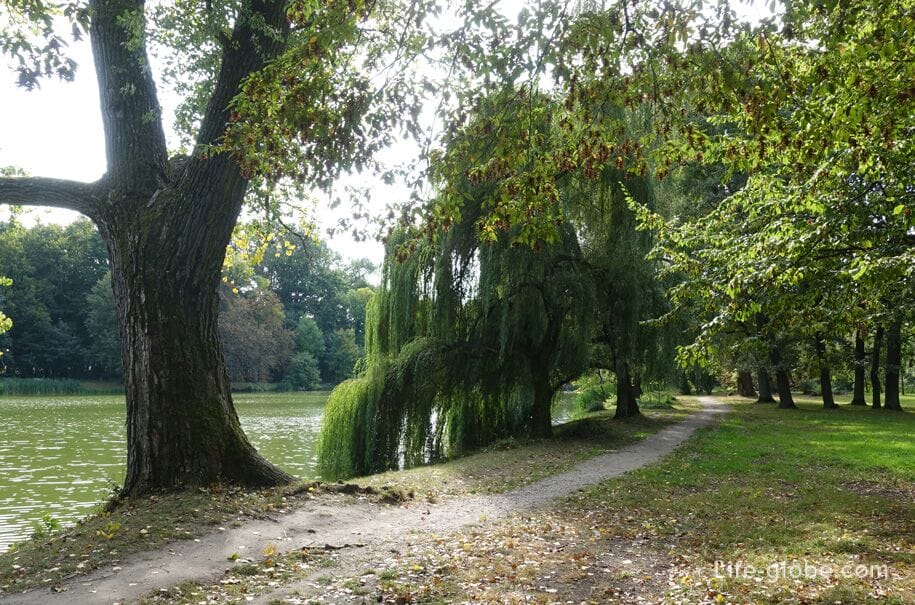
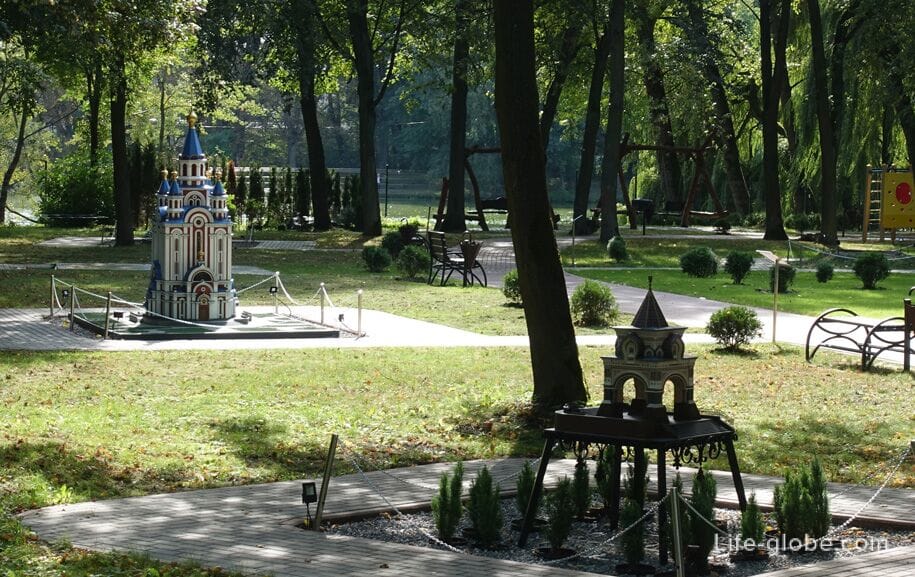
The building of the southern railway station
Kaliningrad-Passenger (Southern railway Station) is the main railway station of the city, serving passenger trains of short (in the region) and long-distance. If you arrive in Kaliningrad by train, then you will get off the train at this station.
The station was opened back in the days of Koenigsberg (the German name of the station Hauptbahnhof) on September 19, 1929 and now the station building itself is a monument of history and architecture.
The project of the building of the Main Station of Konigsberg was developed in 1914 (architect Cornelius), but due to the outbreak of the First World War, construction was postponed until 1920. The grand opening of the station took place on September 19, 1929.
During the Second World War, the station building suffered significant damage. The restored station was opened in 1949. In 2003, the building underwent a large-scale reconstruction, but the general architectural appearance of the historic station was preserved.
Station address: 13-25 Zheleznodorozhnaya Street.
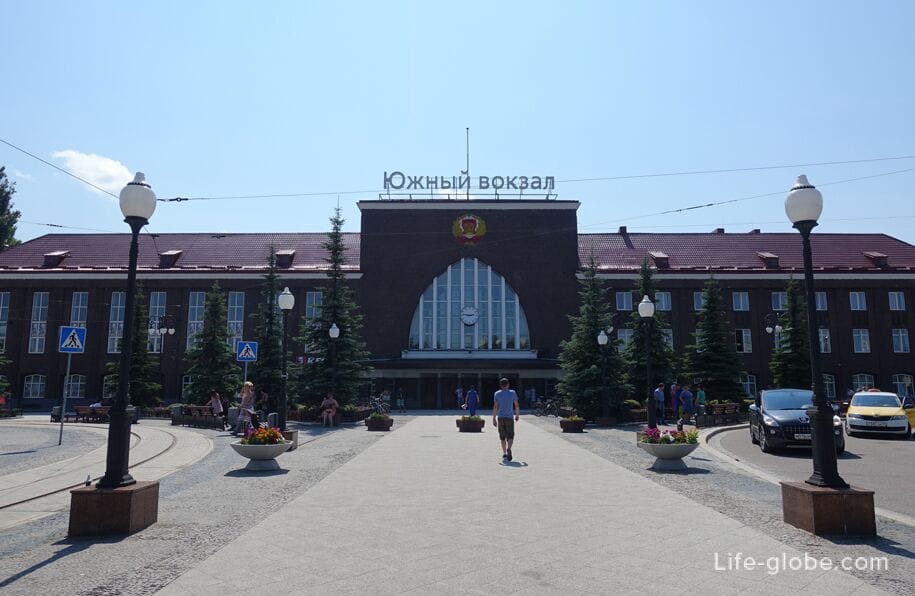

On the territory of the railway complex, near the main building of the Southern Railway Station, there is a museum of the history of the Kaliningrad railway, which is an exhibition of full-scale railway equipment (now not used for its intended purpose), located in the open air. More about the Kaliningrad Railway Museum...
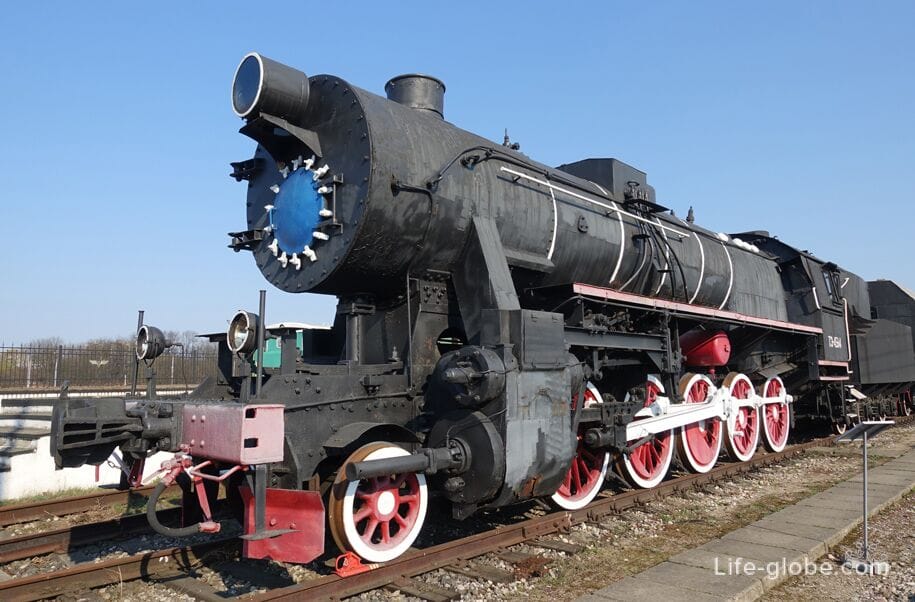
Next to the building of the Southern Railway Station is Kalinin Square, the center of which is decorated with a monument to M.I. Kalinin, installed in 1959. The work of sculptor B. Edunov and architect A. Gulyaev.
The sculpture of M.I. Kalinin is cast in bronze. It is installed on a pedestal of pink granite, on which the coat of arms of the USSR and reliefs of fifteen flags representing the Commonwealth of the Union republics are carved.
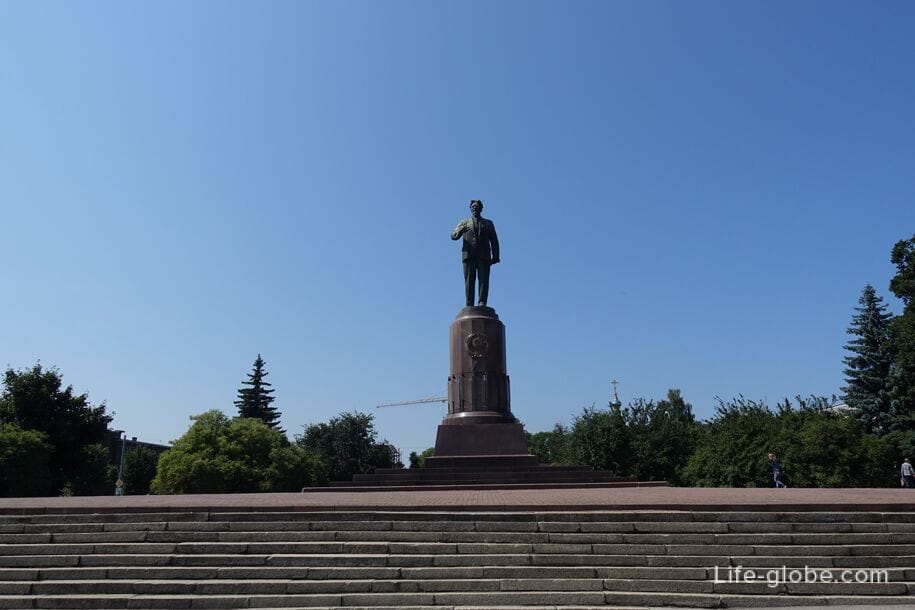
Kirha Juditten
The Juditter Kirche, now St. Nicholas Church and Convent, is a former Catholic order, and later Lutheran, parish church of the Virgin Mary.
This is the oldest religious building preserved in Kaliningrad. It is an architectural monument of Early German Gothic of the 13th-14th centuries and is known as the oldest Gothic structure in the entire Kaliningrad region.
The exact date of the construction of the first church has not been definitively established, but the approximate date of the foundation of the shrine is considered to be 1276-1288. The church was built by the Teutonic Order and was originally a fortress temple. During the history of the church was subjected to various modifications - it was reconstructed, improved and completed.
During the fighting of the Second World War, the church was not significantly damaged. In Soviet times, it was destroyed and dilapidated.
In the early 1980s, it was decided to convert the ruins of the Juditten church into an Orthodox church. In 1987, the church was consecrated, but restoration work continued until 1990.
The address of the Juditten Church: 39b Shady Alley Street.
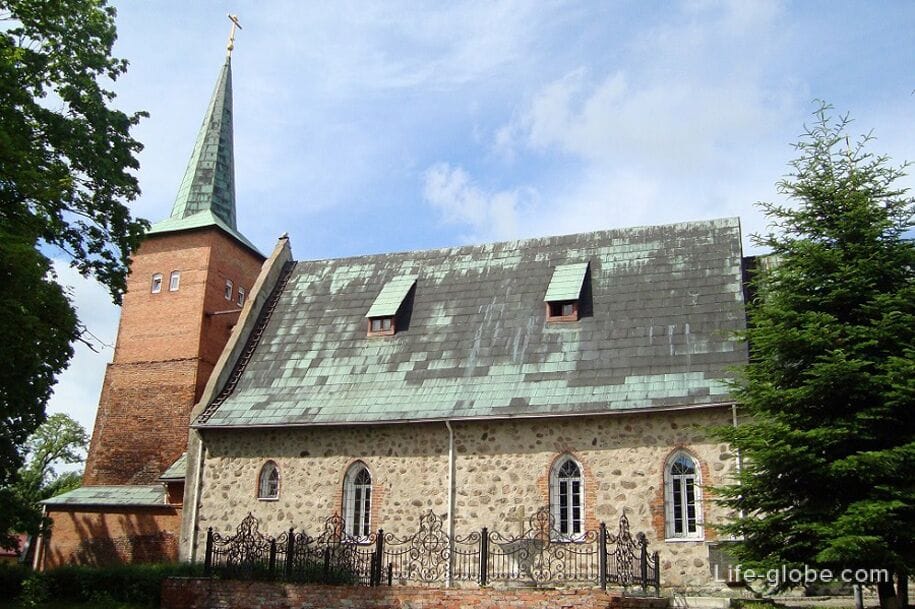
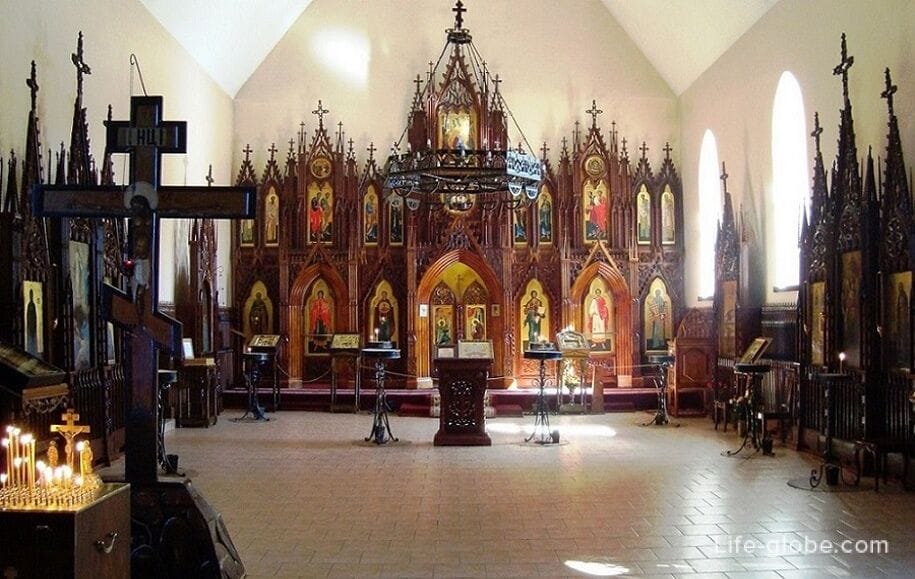
St. Adalbert 's Church
The Roman Catholic Parish of St. Adalbert (church) has been operating since 2005 as a Catholic church. The construction was carried out with the money of German foundations, donations from the parishes of Poland and Kaliningrad.
In 2016, in addition to the two electronic organs installed in the church, the parish received as a gift an ancient organ from the closed evangelical church of the German city of Bochum.
The address of the church: Alexander Nevsky Street, 78-V.
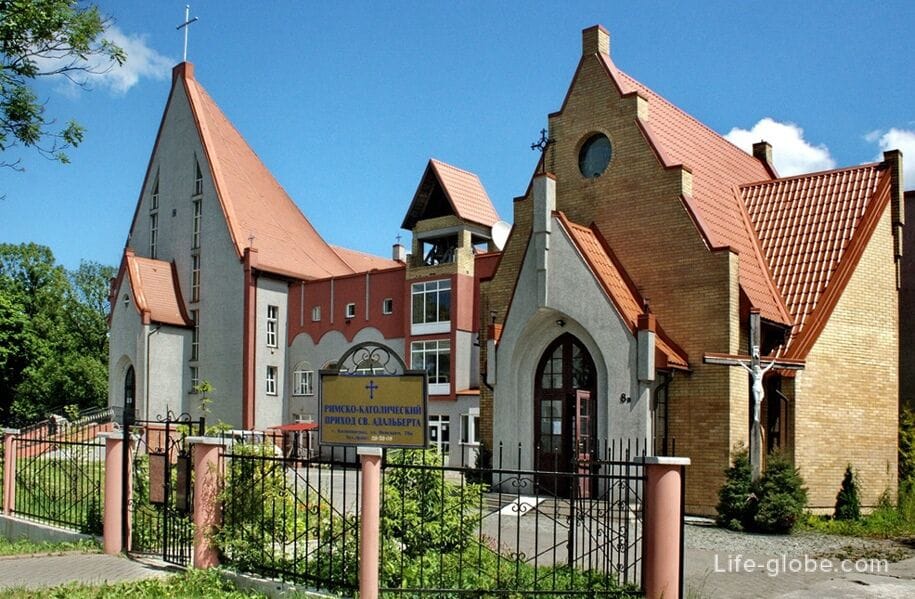
International Memorial Cemetery of the Victims of World War II
The International Memorial Cemetery of the Victims of the Second World War was originally a communal cemetery where the victims of the bombing of August 1944 and the storming of Konigsberg in April 1945 were buried - civilians, soldiers of the German army, prisoners of war of various nations.
The cemetery was consecrated on August 23, 2003.
The memorial cemetery is located along Alexander Nevsky Street.
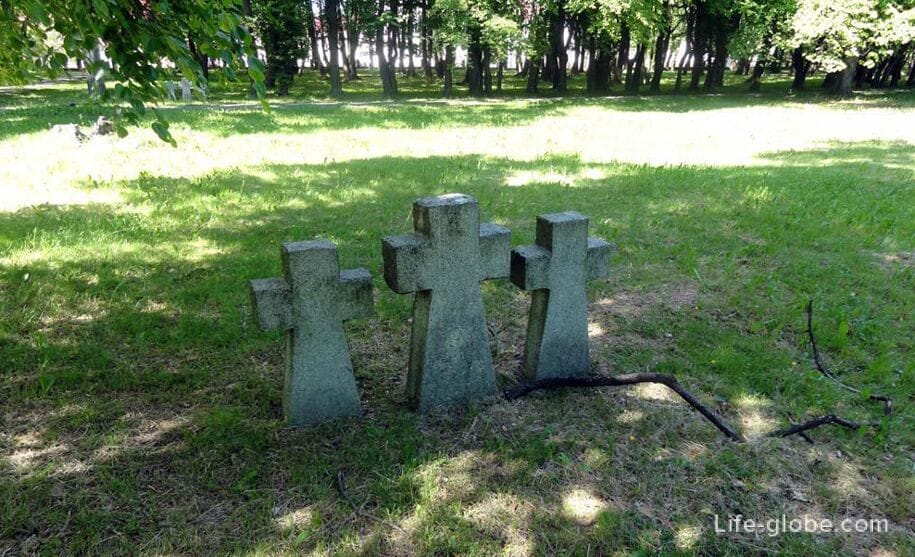
Armenian Church of St. Stepanos
The temple of the Armenian Apostolic Church in honor of Saint Stepanos Syunetsi was founded on October 14, 2006 and consecrated by Bishop Ezras Nersesyan.
The church building was built according to the project of architect Ruben Azatyan. The height of the building, together with the spire, is 21 meters, and its area is 280 sq.m. The walls of the shrine are lined with pink tuff and decorated with bas-reliefs.
Today, the church has a Sunday school and an Armenian Cultural Center, which hosts concerts and various events.
The church address is: Herzen Street, 1. Near the church there is a Mass grave of Soviet soldiers.
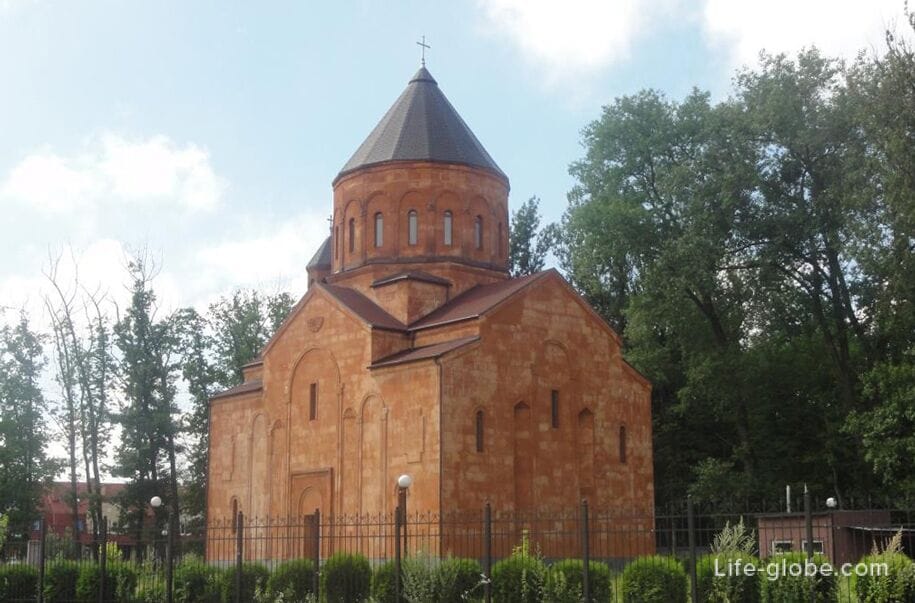
The Church of St. Gerasim Boldinsky
Permission for the construction of the temple was obtained in 2003.
The parish of the church was consecrated on August 20, 2006 by Metropolitan Kirill of Smolensk and Kaliningrad.
In early 2008, a gate with a bell tower was erected near the temple.
The church has a classic appearance, small size and a small territory near the shrine. Nothing special stands out, suitable for connoisseurs of the architecture of classical Russian churches.
The patronal feast is celebrated on May 14.
The address of the temple: Kolkhoznaya Street, 41.
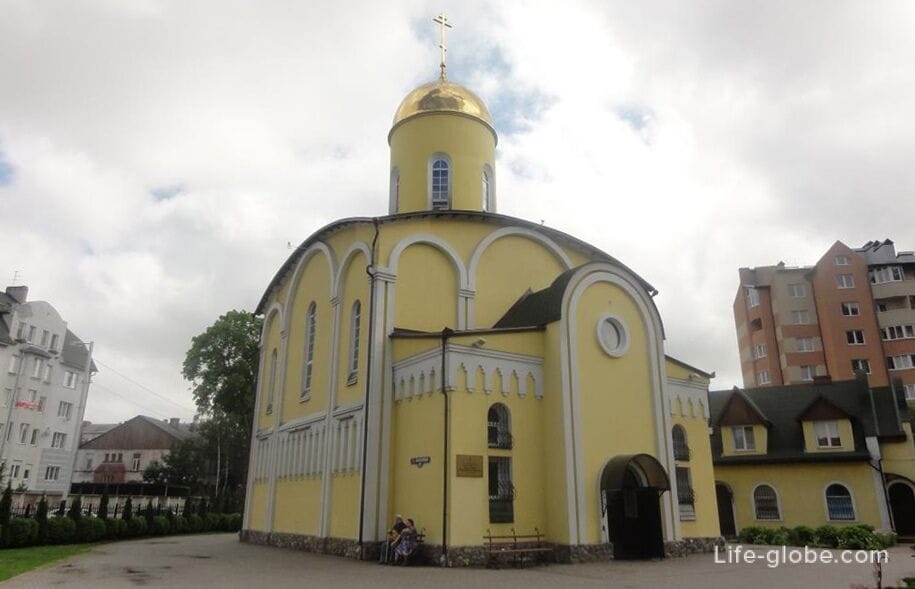
Church of the Archangel Gabriel
The Church of the Archangel Gabriel is a small, now Russian Orthodox Church located at 152 Mira Avenue.
Patronal feast: July 26 and April 8. There is a cemetery nearby.
Evangelical Lutheran Church of the Resurrection
The Church of the Resurrection is an Evangelical Lutheran church, which is the main church of the Kaliningrad Brotherhood of the Evangelical Lutheran Church of the European part of Russia.
The construction of the new Church of the Resurrection began in December 1996, designed by architect Pavel Mikhailovich Gorbach. The first service in the church was held on November 29, 1998. The church was officially consecrated on April 11, 1999.
It is noteworthy that the foundation of the church is a cross made of bricks of the destroyed evangelical church.
In 2008, the 1960 organ, which had previously been located in the evangelical church in the city of Nordorf (Germany), was transferred to the church.
The church's address is 101 Mira Avenue.
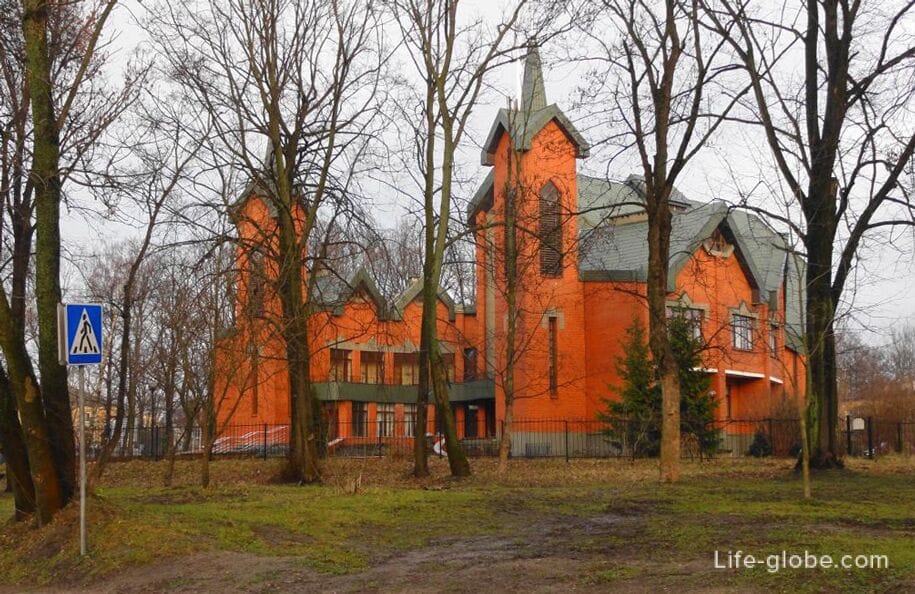
Separate independent categories of Kaliningrad attractions include
Kaliningrad Museums
Kaliningrad is also rich in museums, some of which are known outside of Russia.
Kaliningrad museums, at their core, tell about the history of the region, its nature, inhabitants and their way of life during the time of Konigsberg and later Kaliningrad.
The main museums of the city include:
- Amber Museum, located in the historic Dona Tower;
- World Ocean Museum complex;
- museum located in the former Friedland City Gate;
- the Kant Museum, located within the walls of the Cathedral;
- the Museum of Fine Arts, located in the building of the former stock exchange;
- Kaliningrad Regional Museum of History and Art;
- Bunker Museum;
- museum exhibitions located in Fort No. 11 and Fort No. 5.
The apartment-museum Altes House is also interesting, showing the situation of apartments in East Prussia and the life of citizens of the 19th - early 20th centuries. Learn more about all Kaliningrad museums...
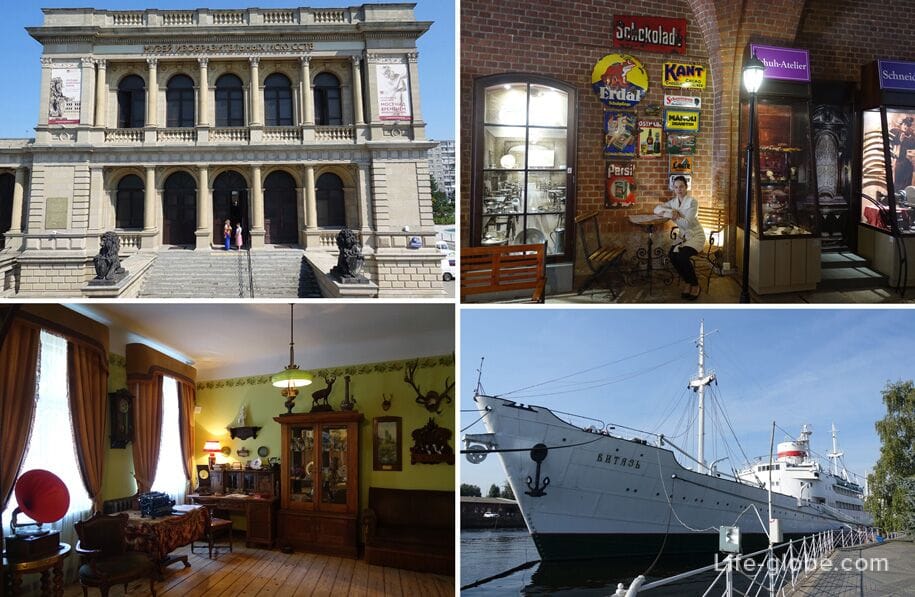
Homlins in Kaliningrad
There is a small art object in Kaliningrad, which from the very first days of its creation won the hearts of local residents and guests of the city - these are cute and very cute homlins.
Homlins are mythological creatures, like brownies, who, according to legend, live next to people, and at night they make amber products. According to legend, homlin brings happiness and goodness.
Kaliningrad sculptures of Homlins represent members of one large family - from the older generation (grandparents) to the youngest.
The figures of the Homlin family themselves with a good-natured appearance and "mouse ears" have miniature dimensions and are installed in iconic places of the city. Learn more about homelins in Kaliningrad...
